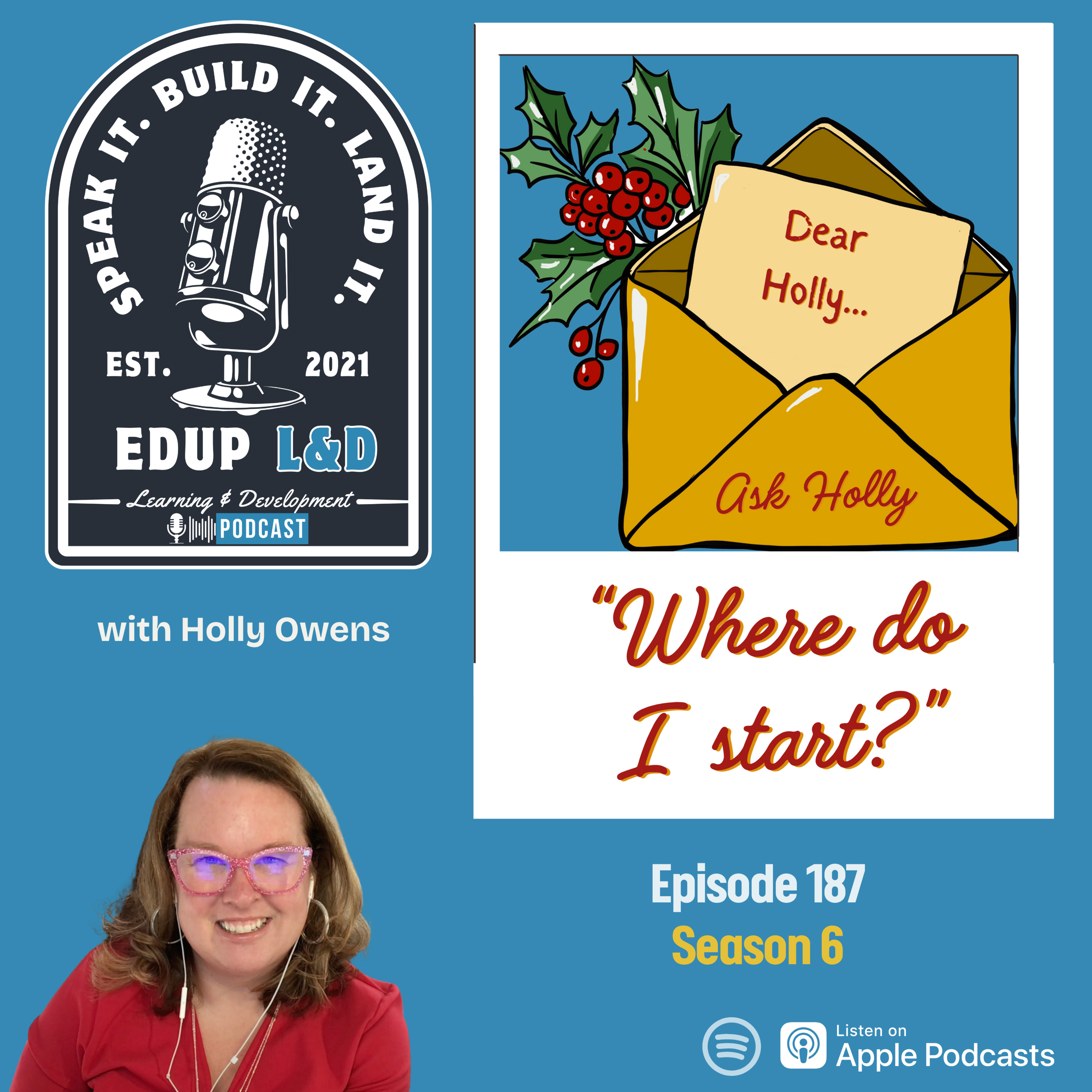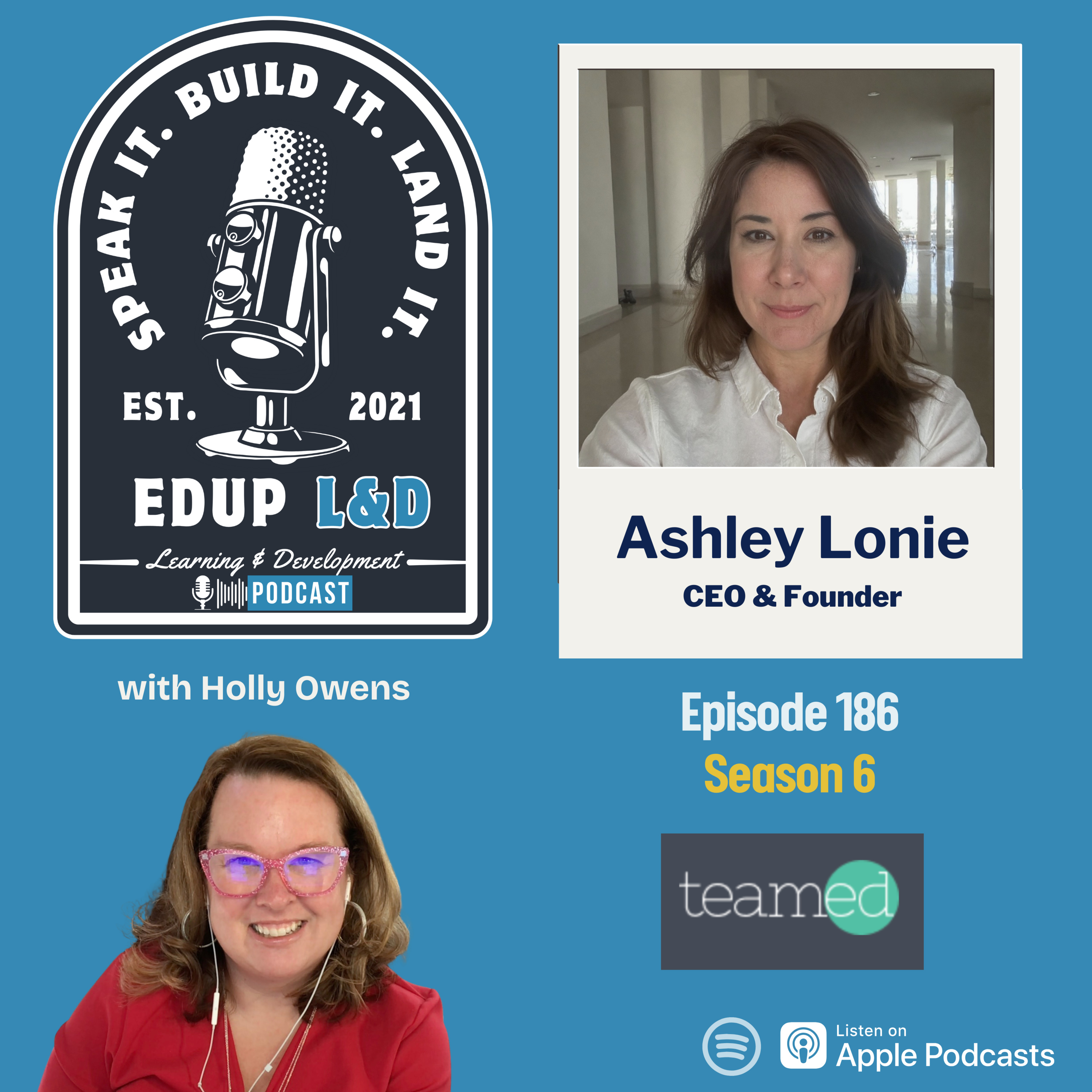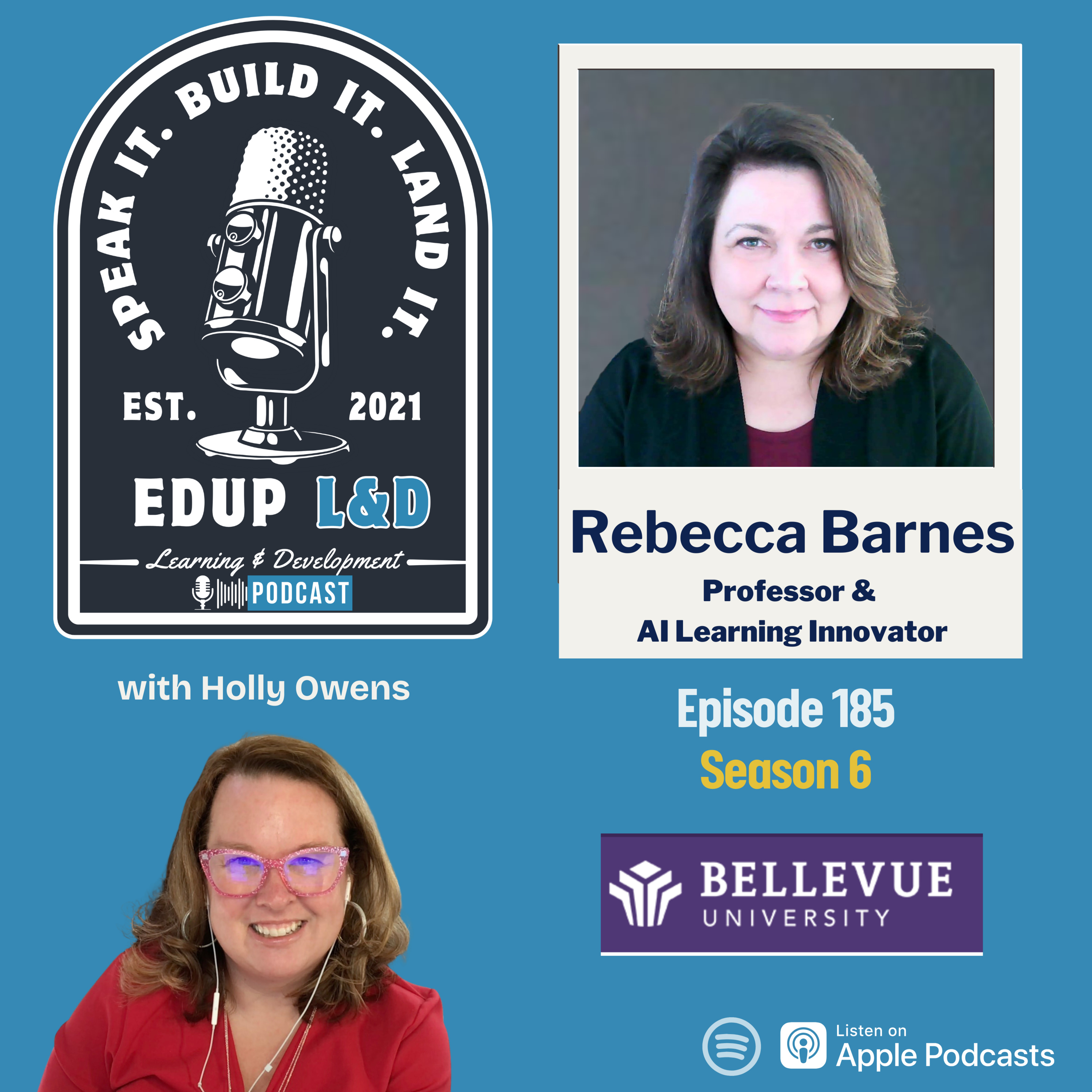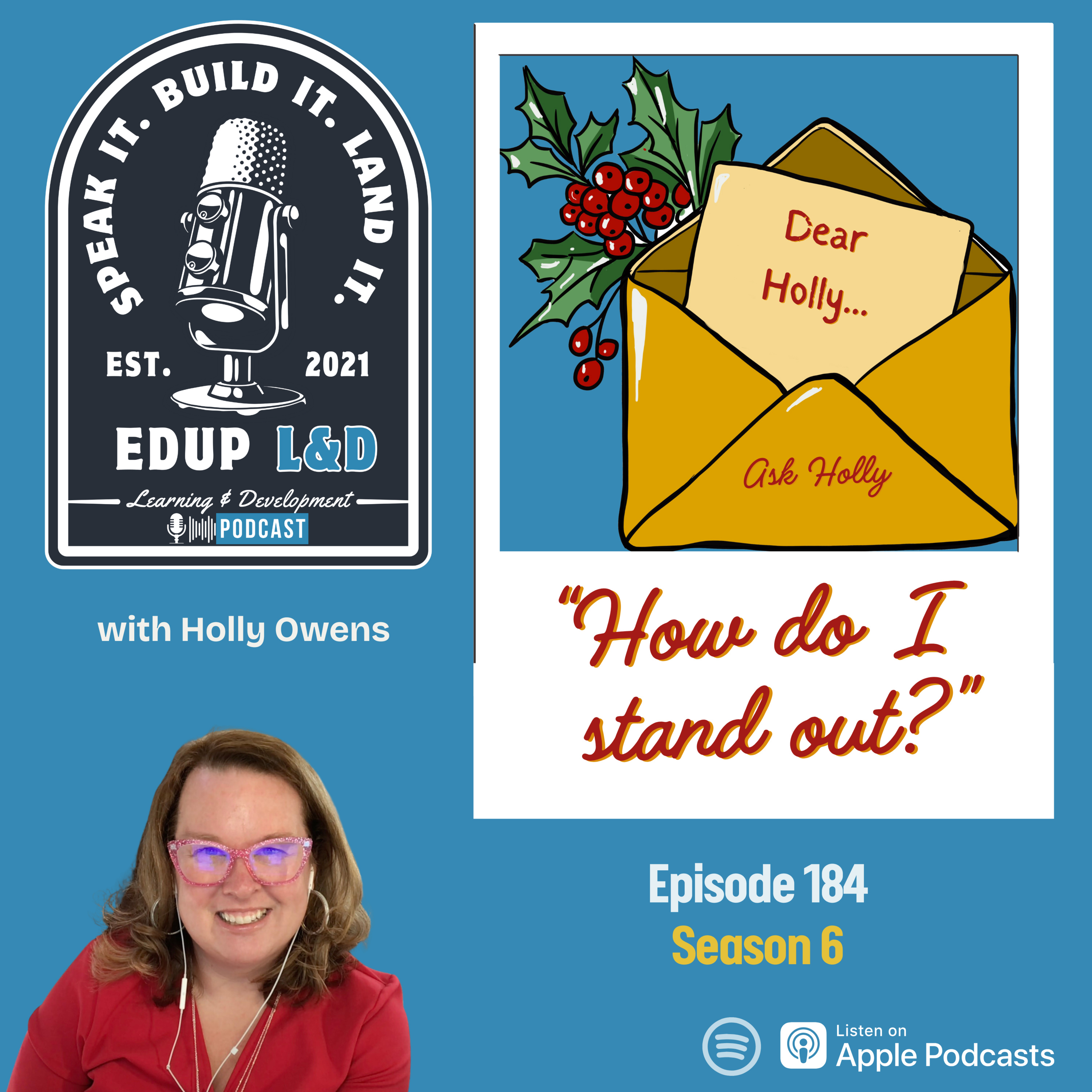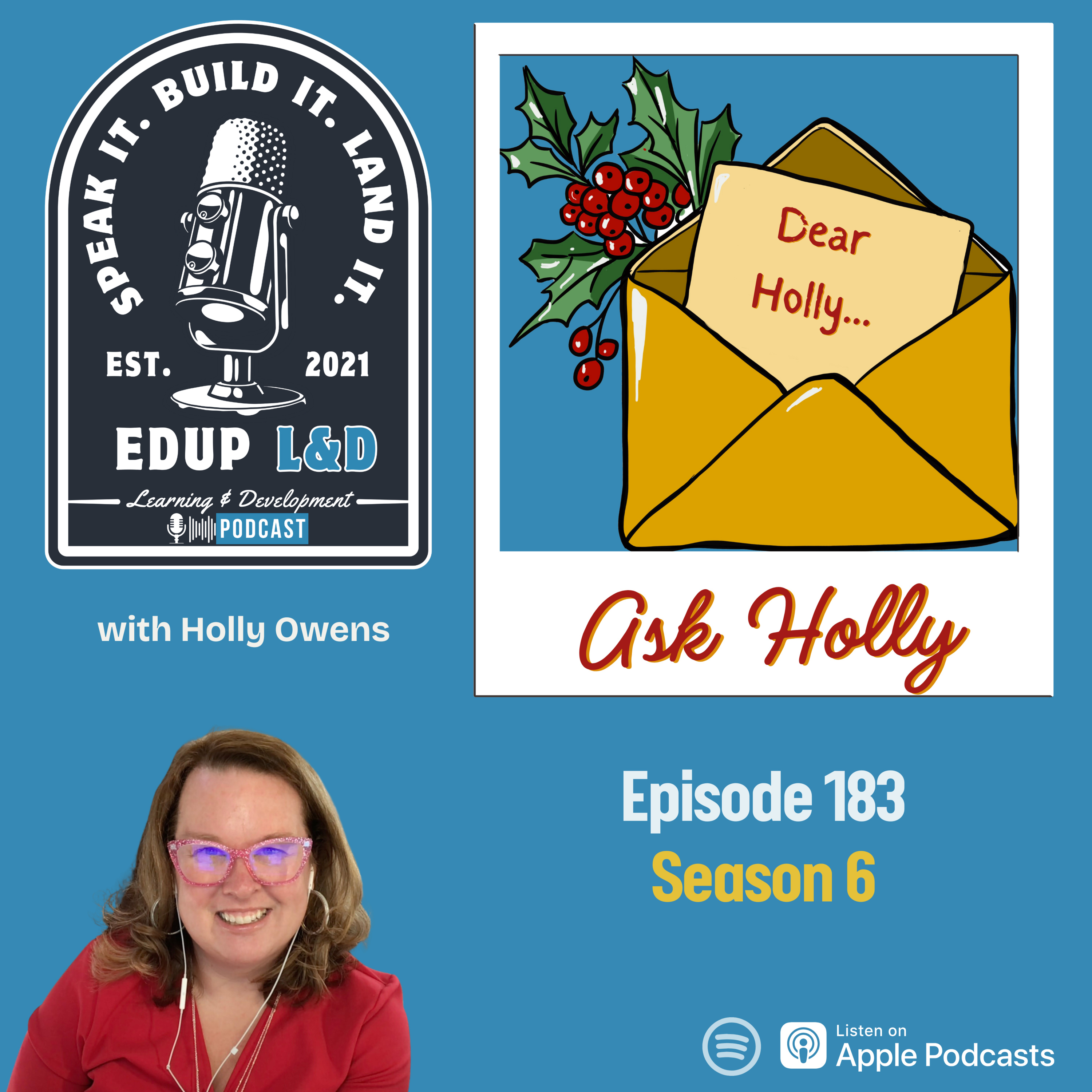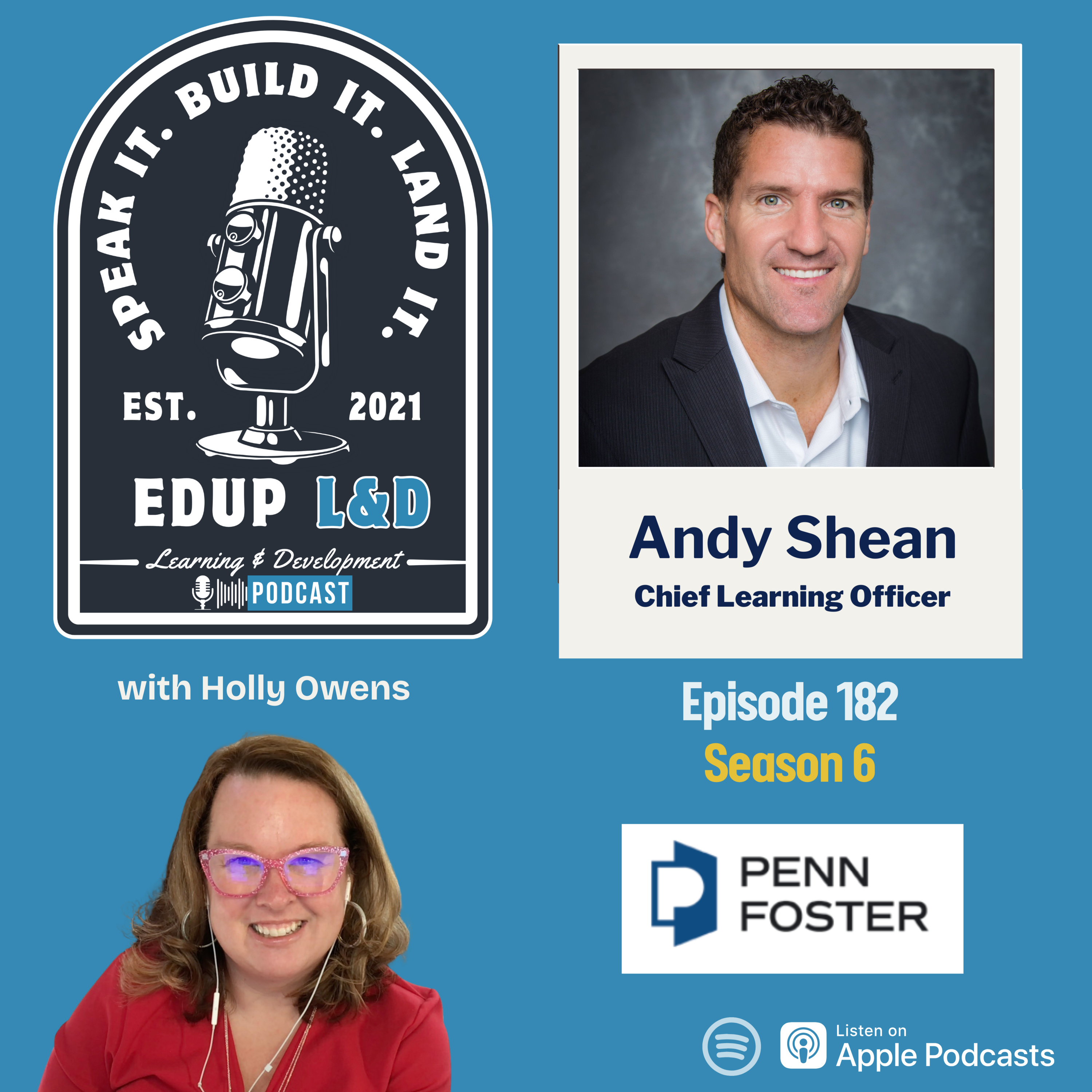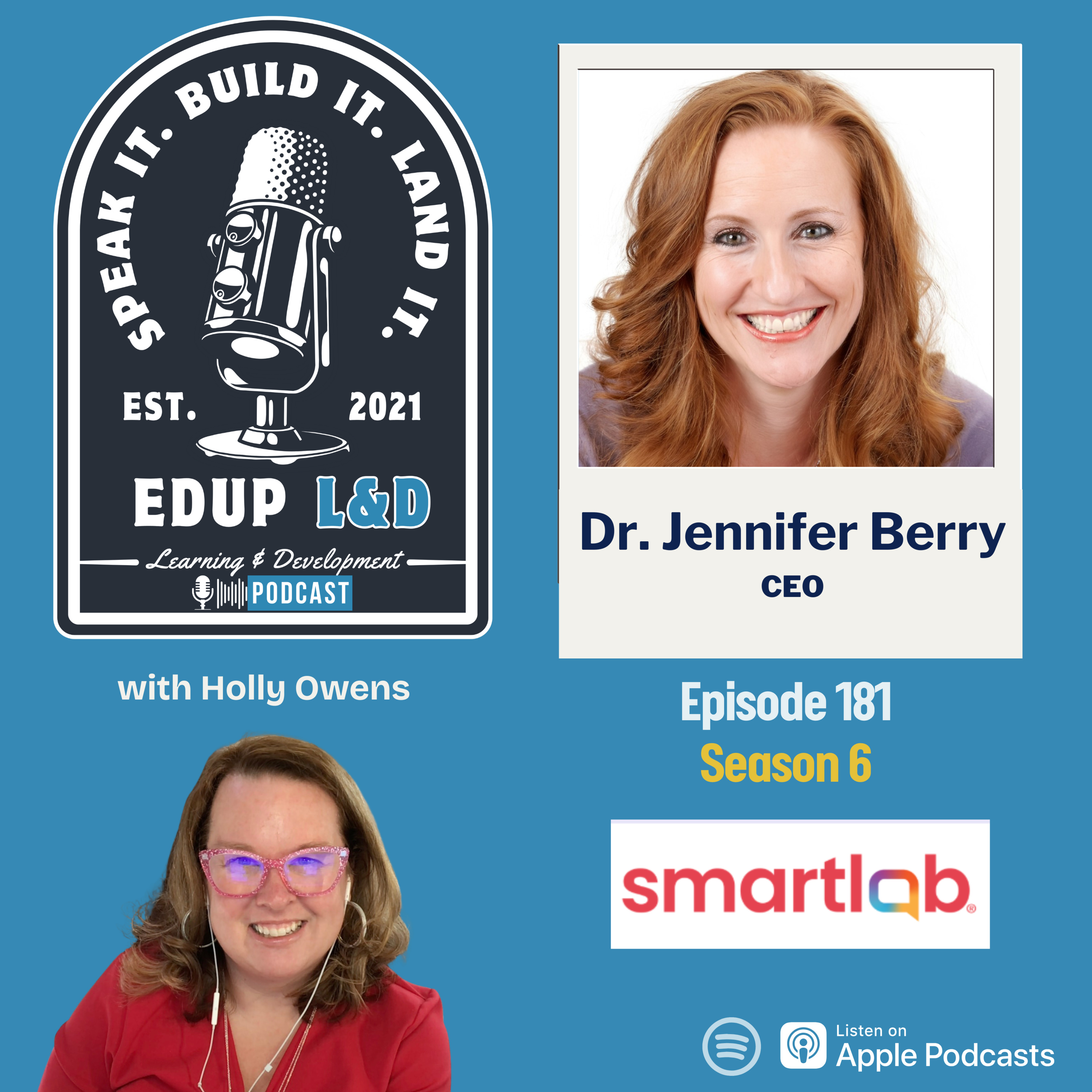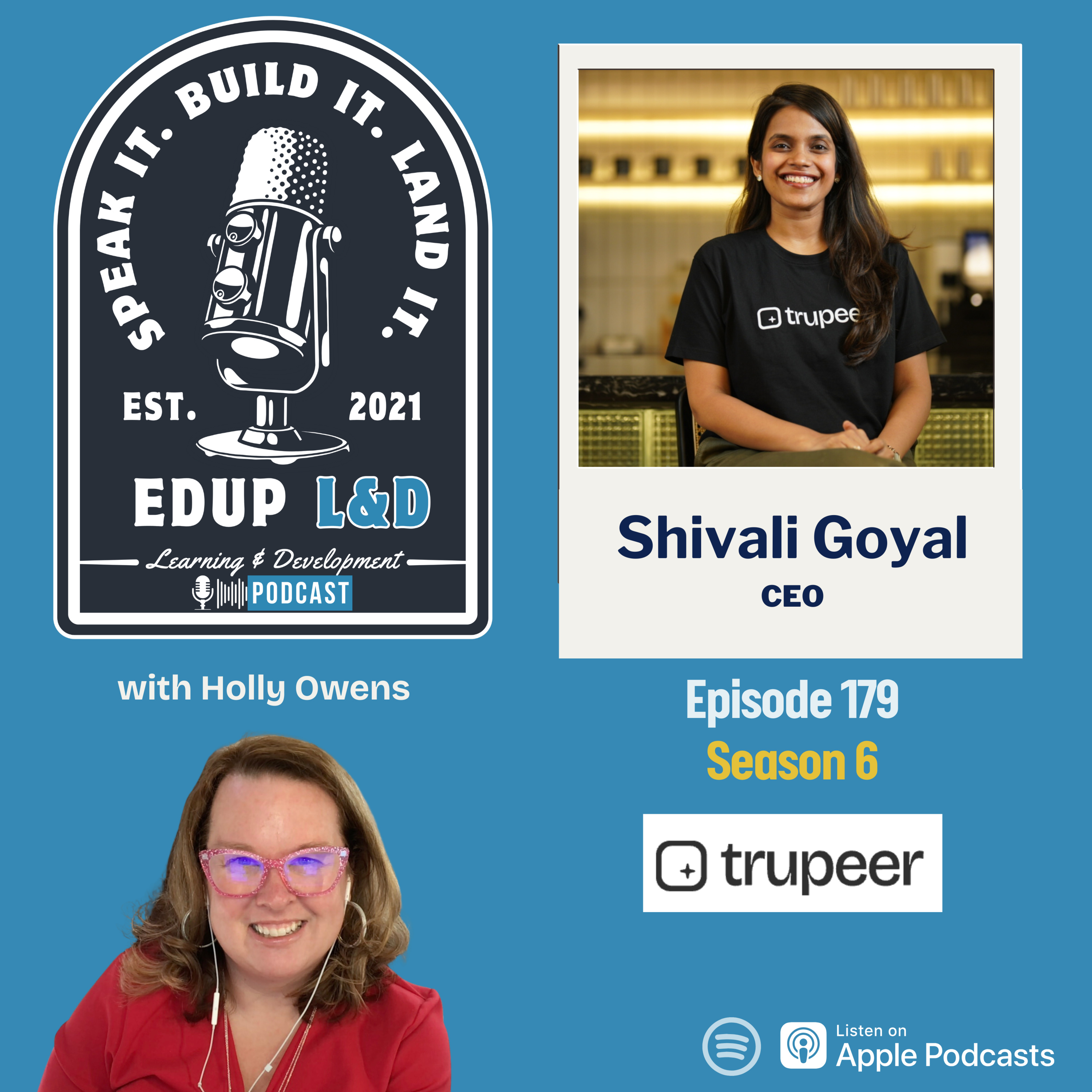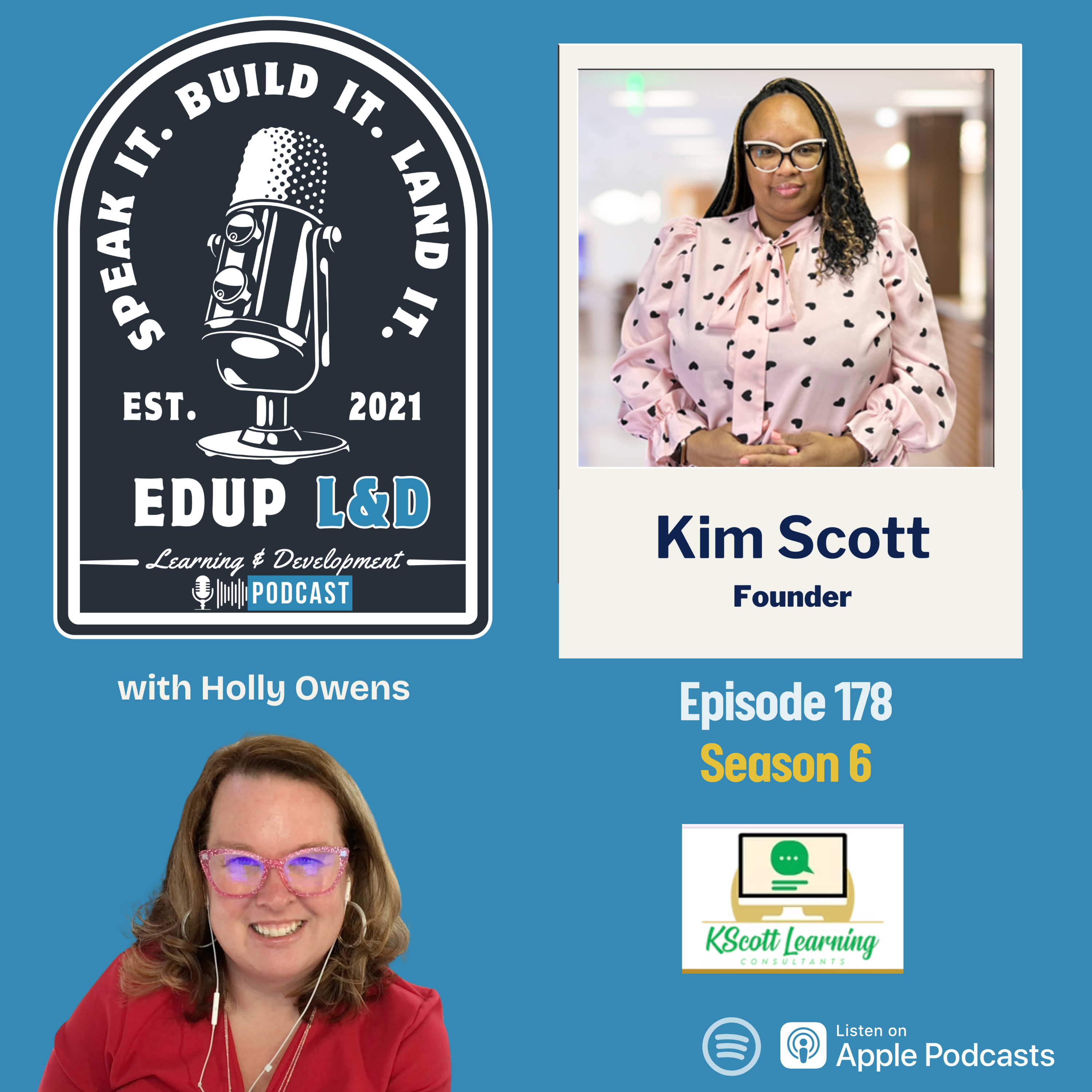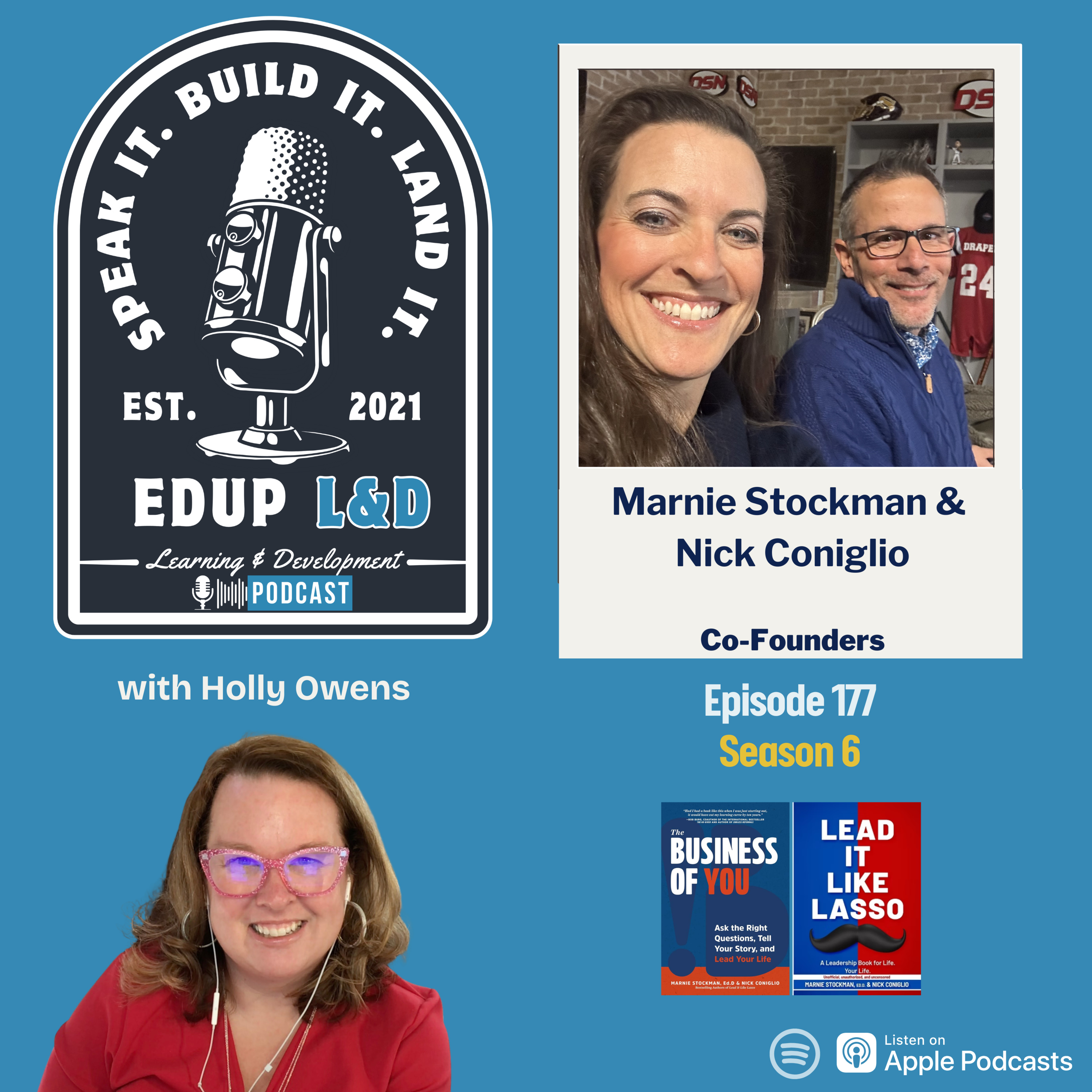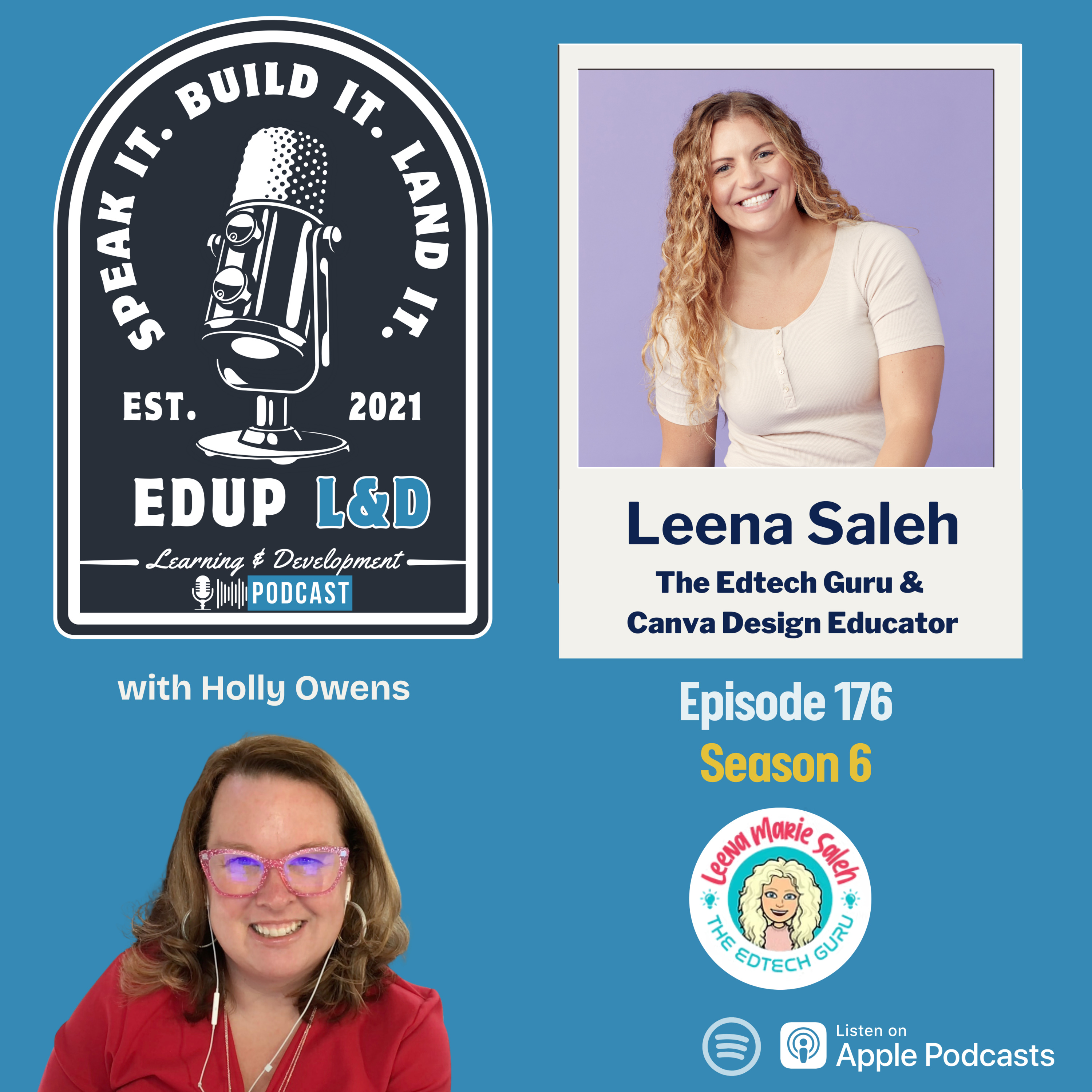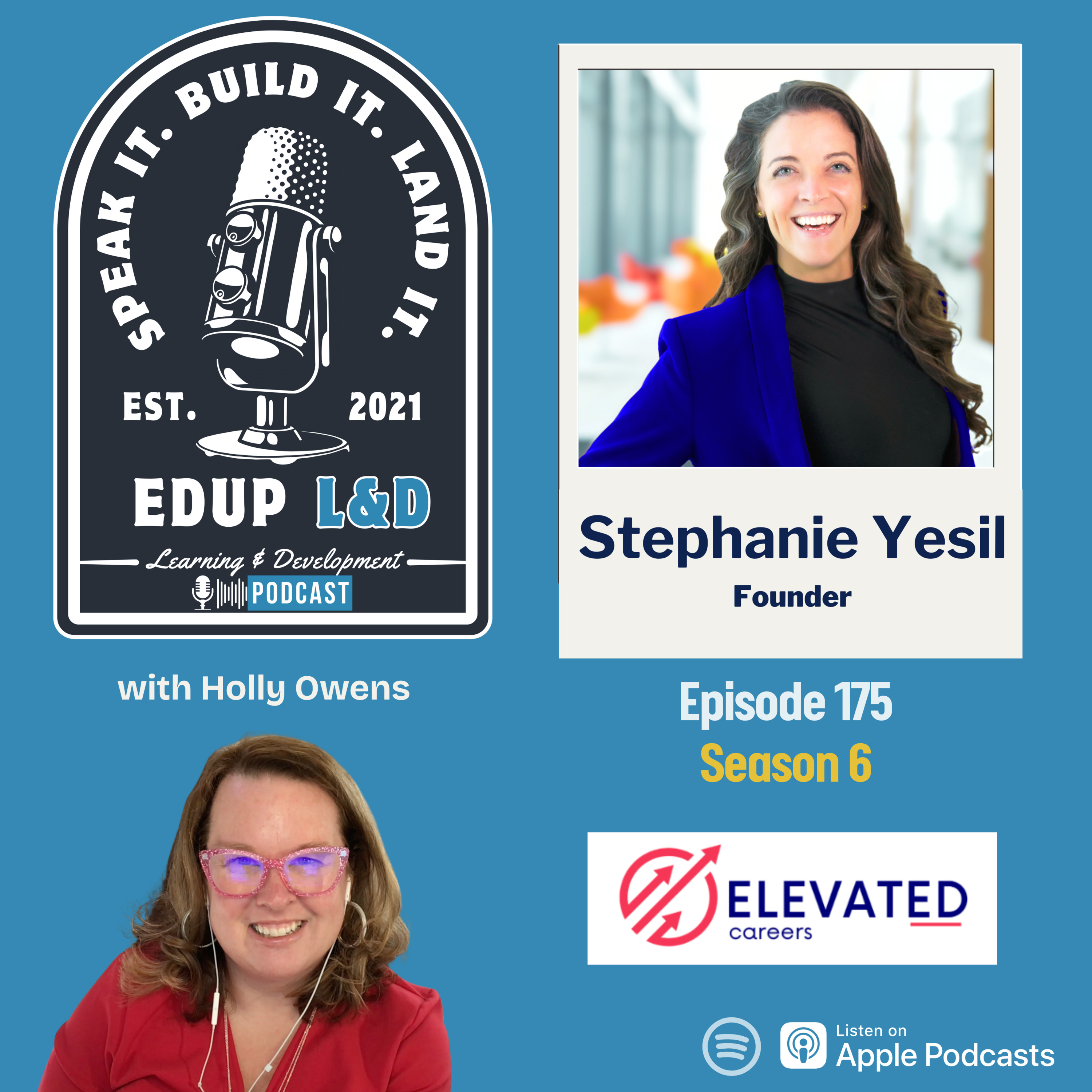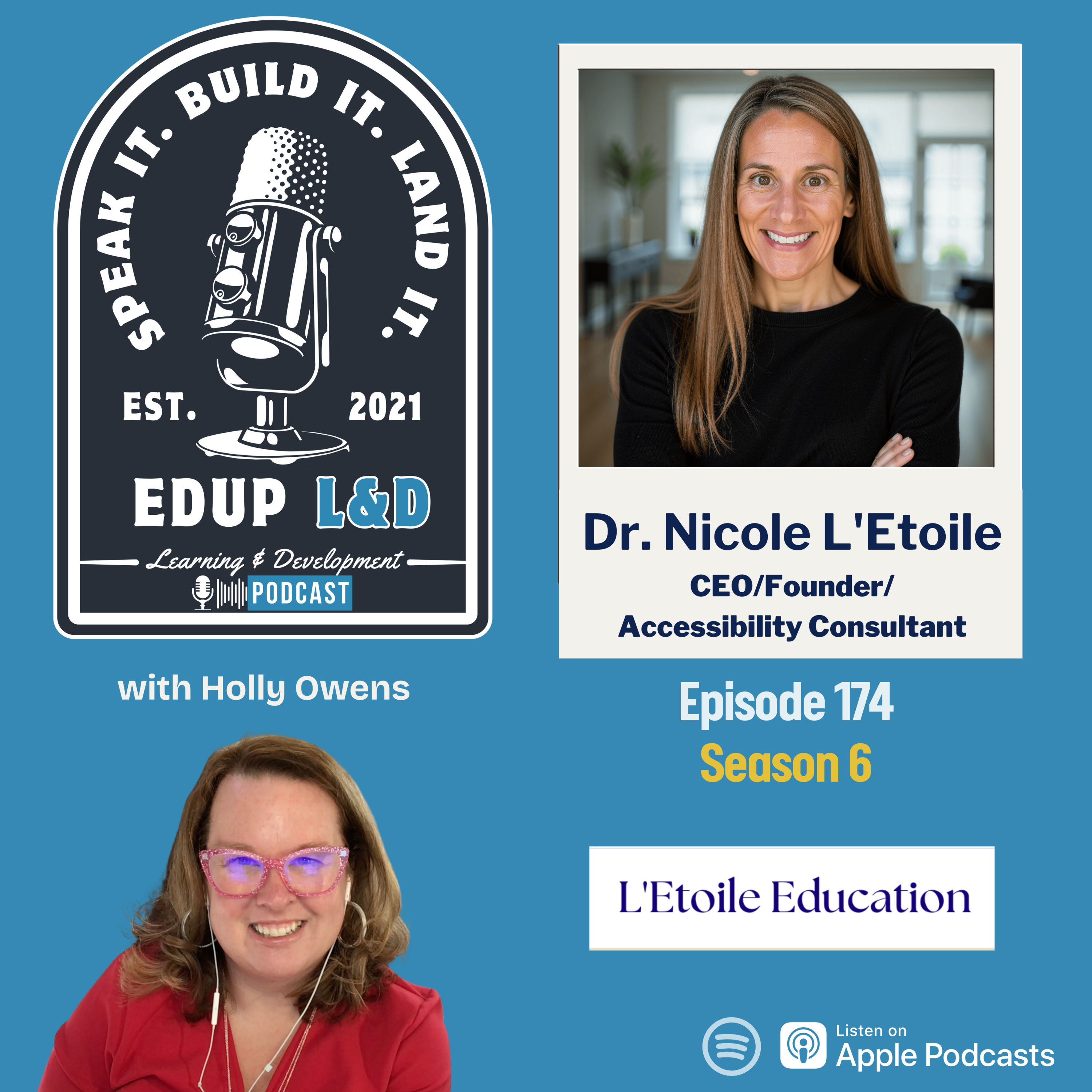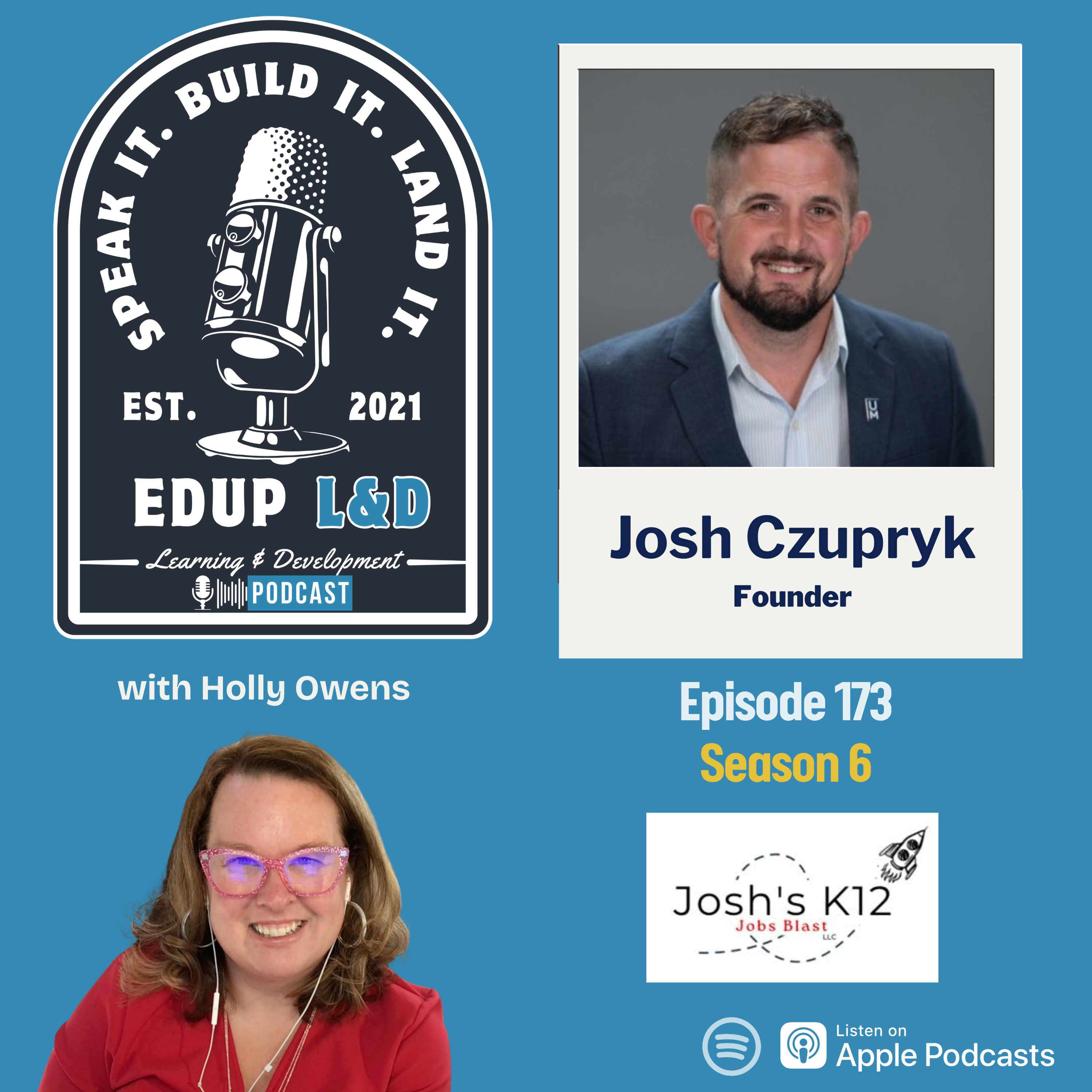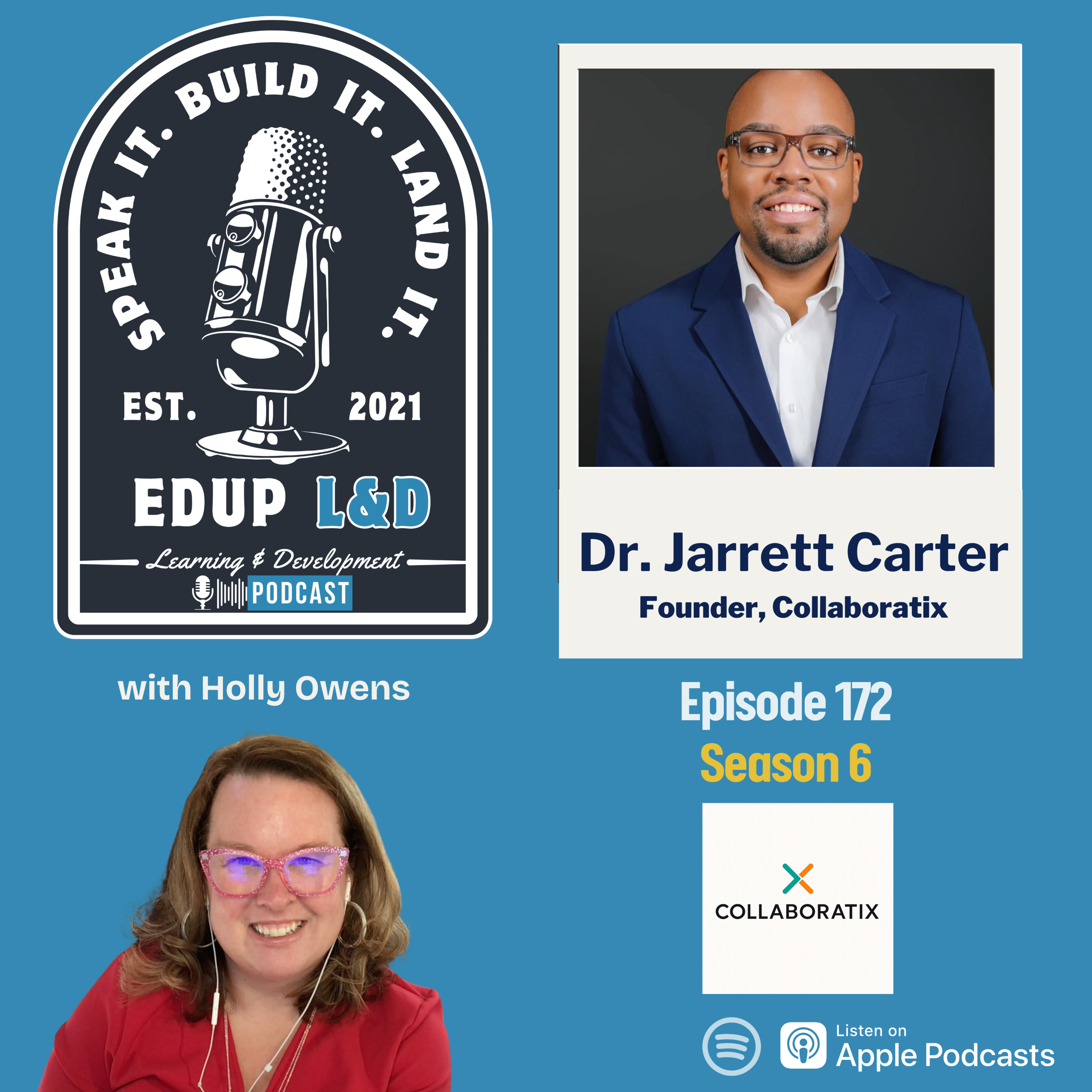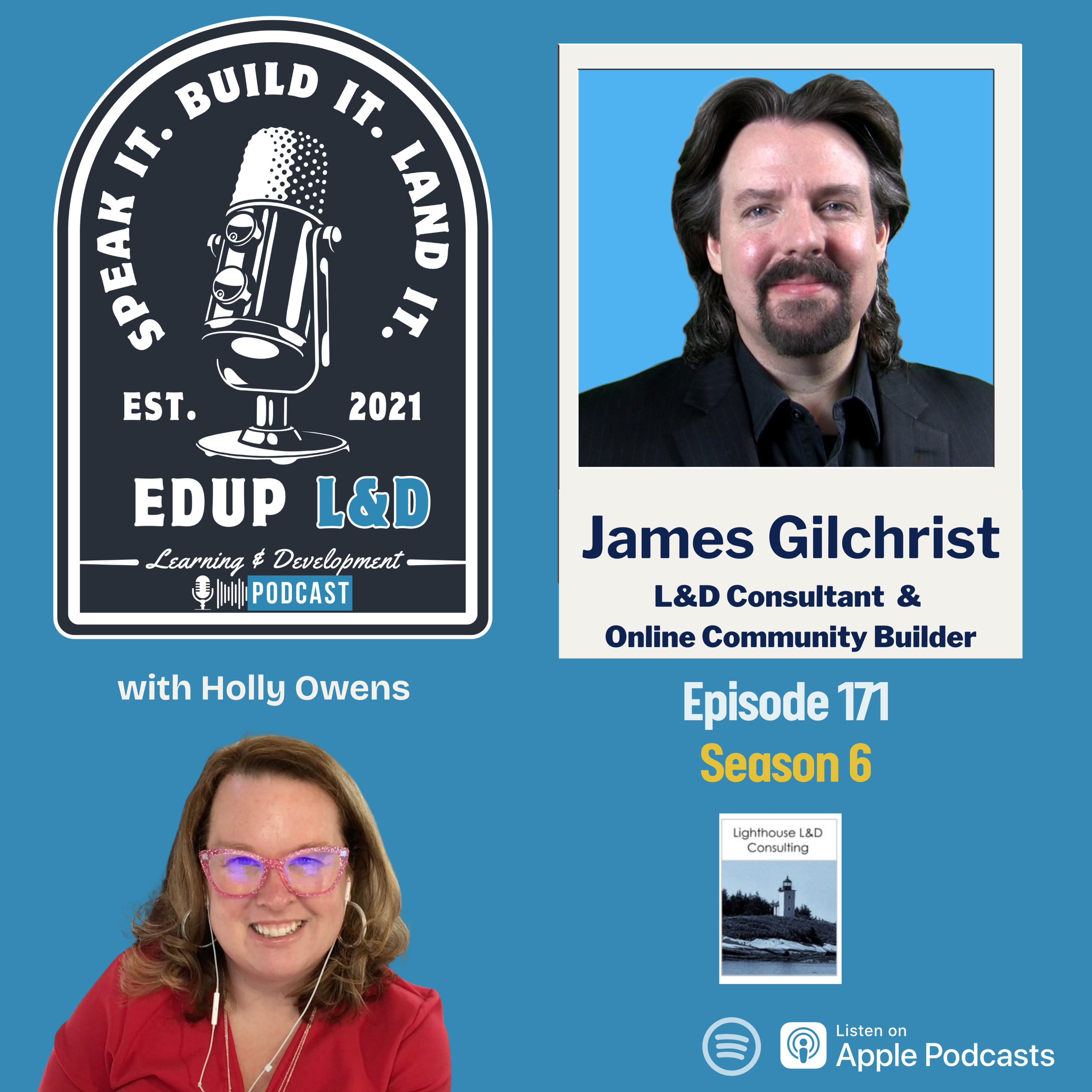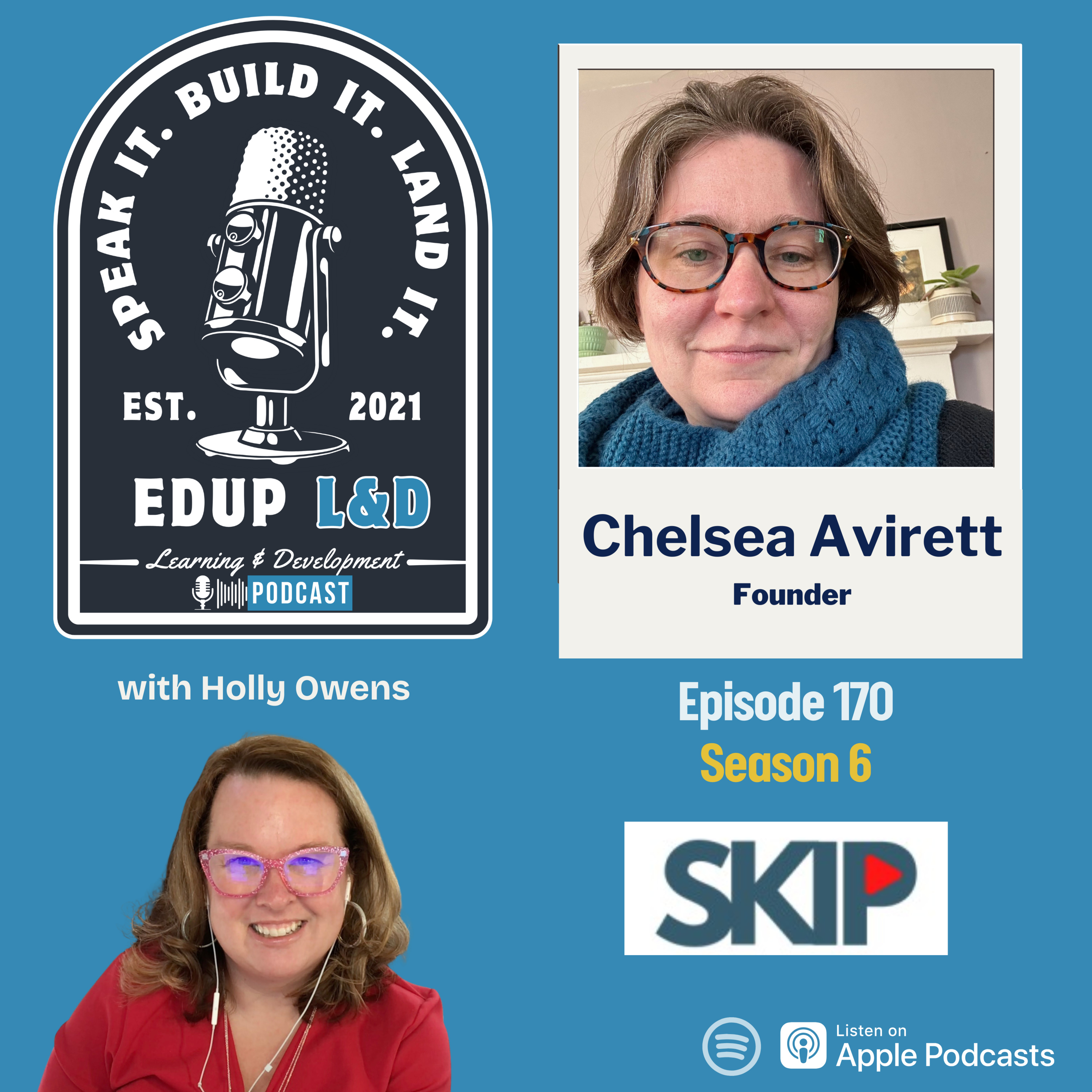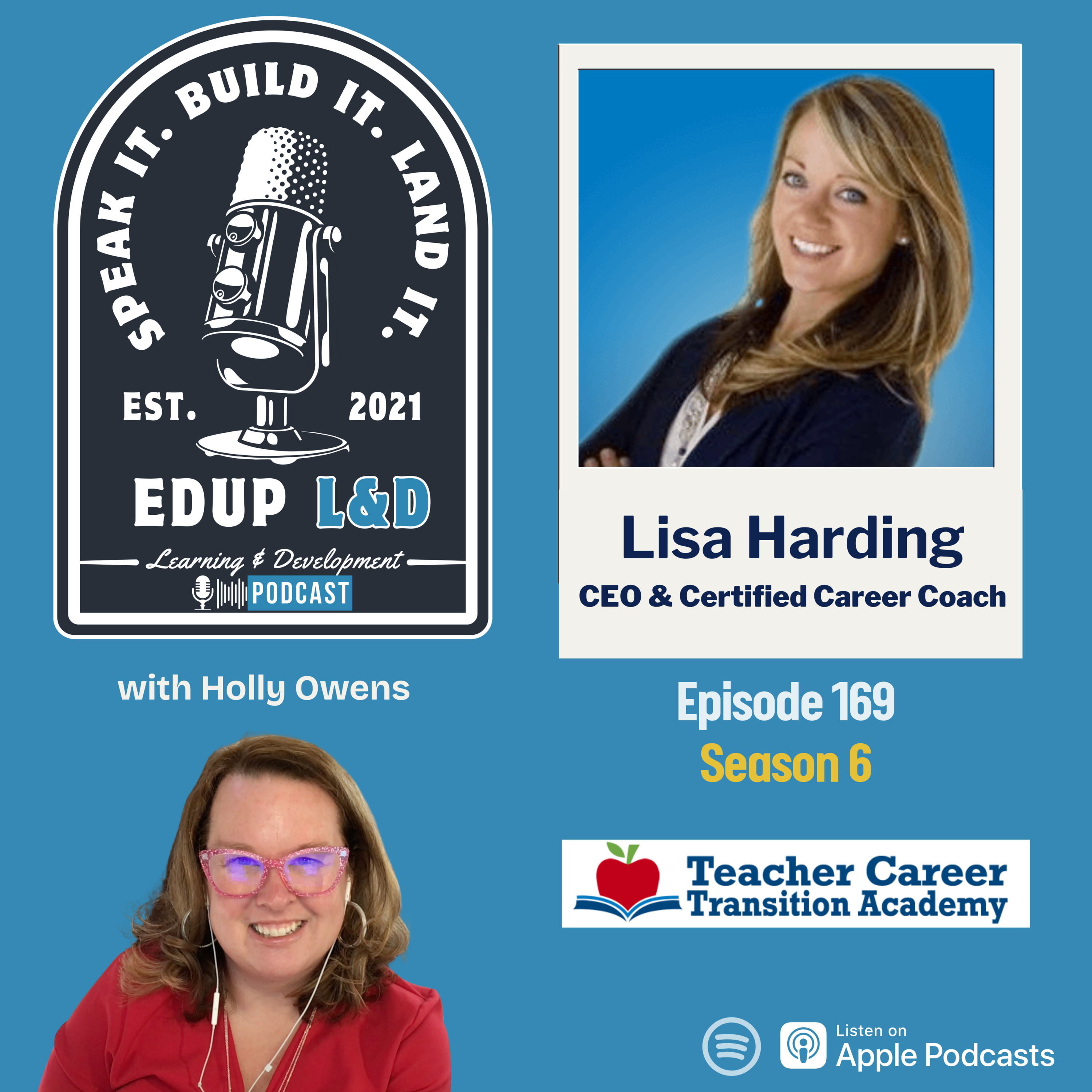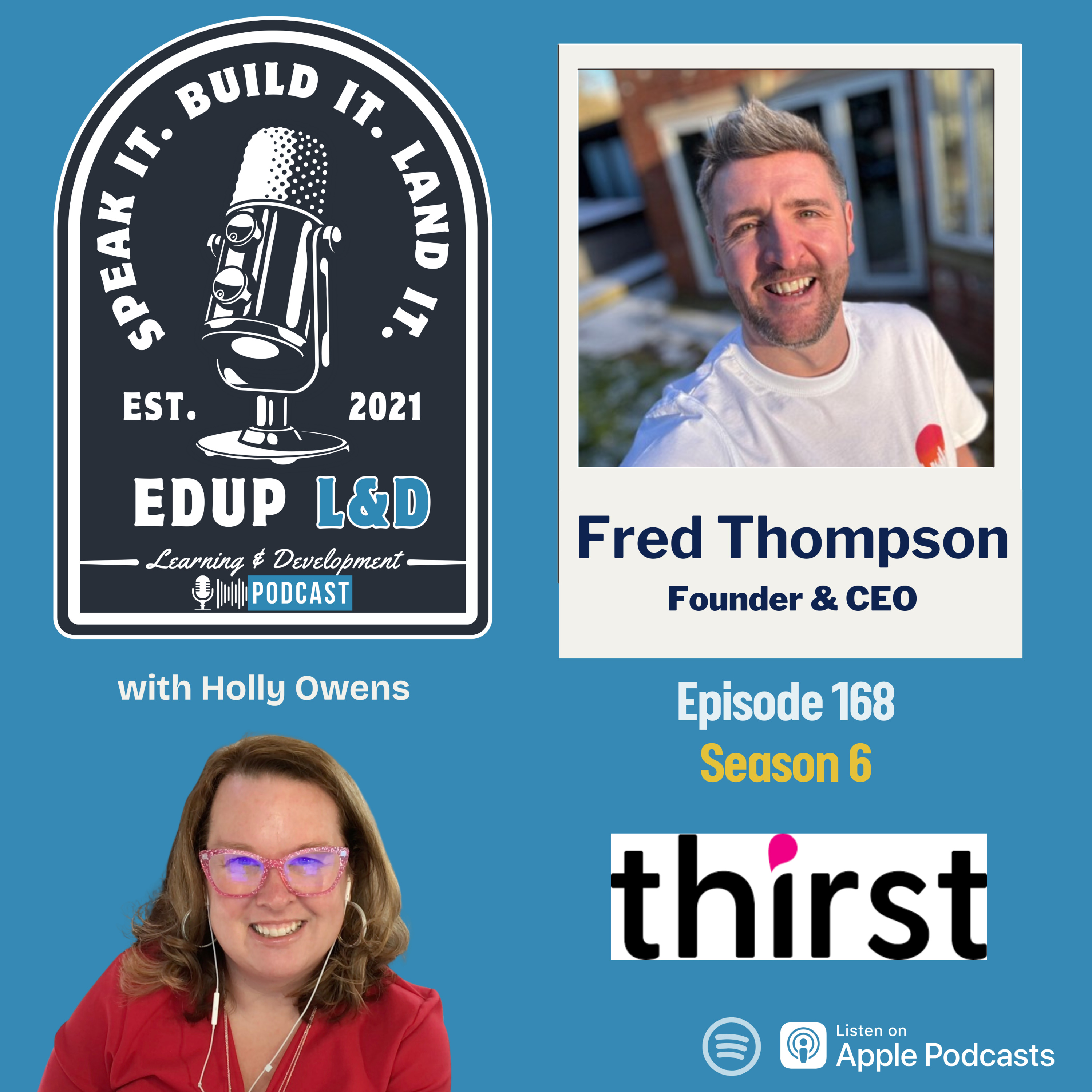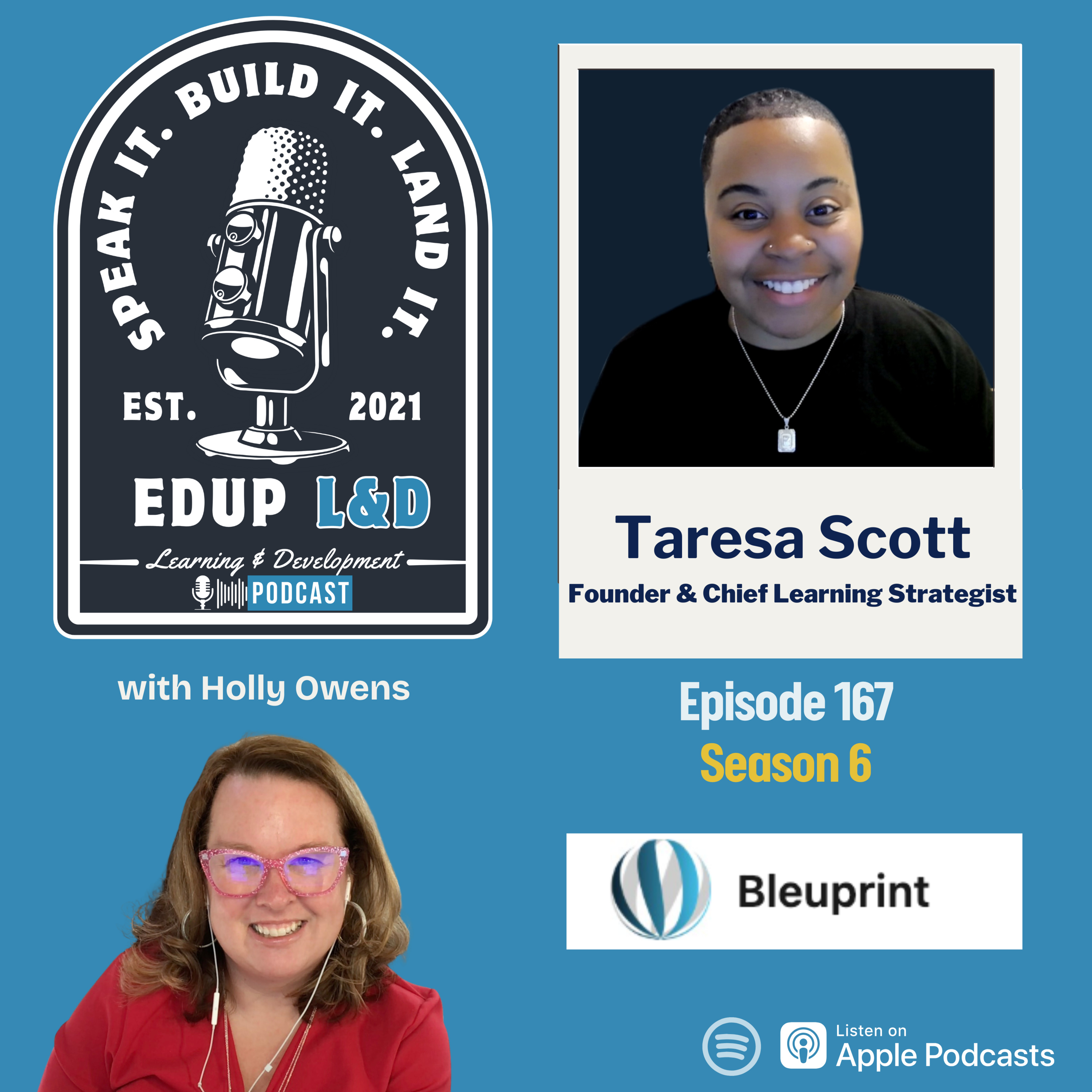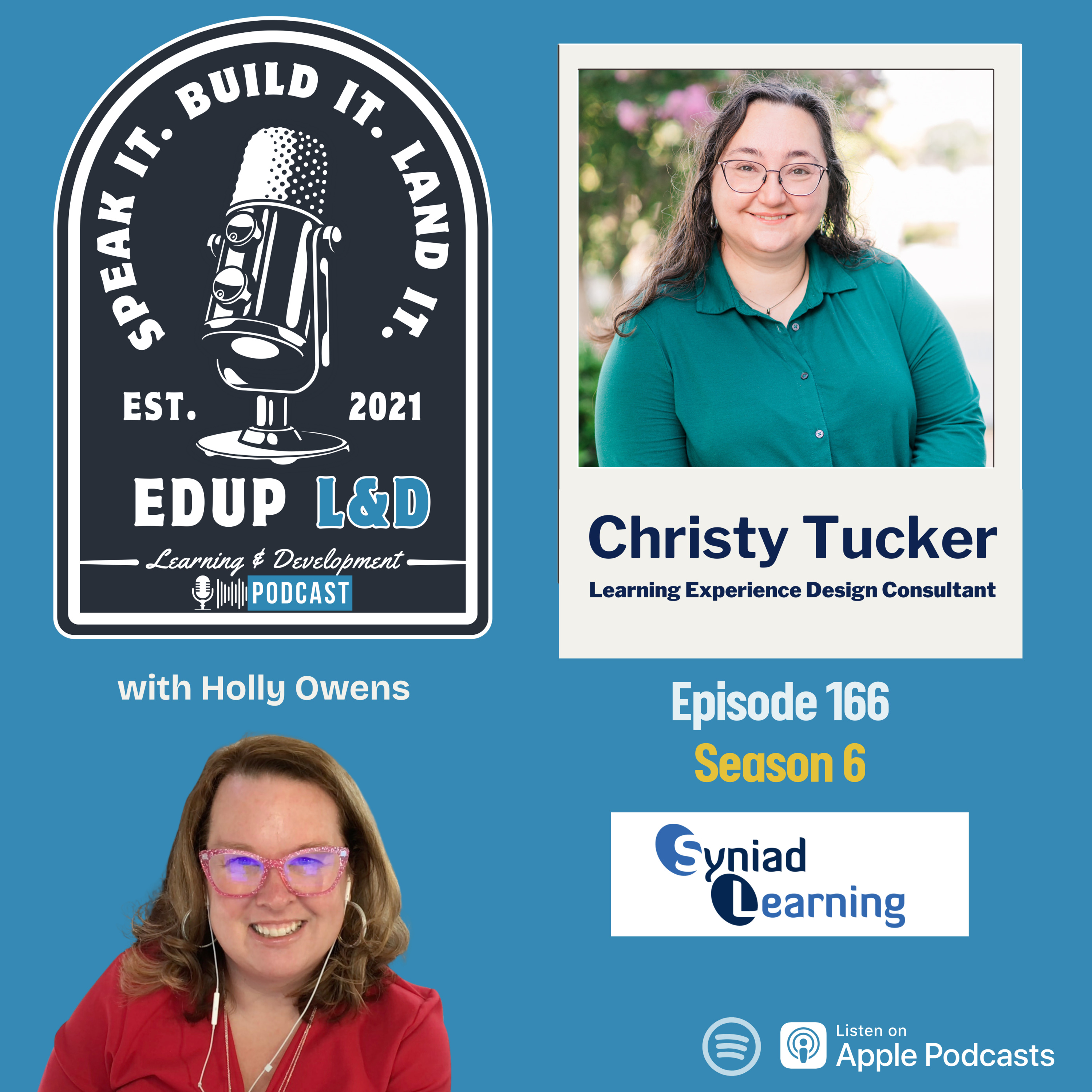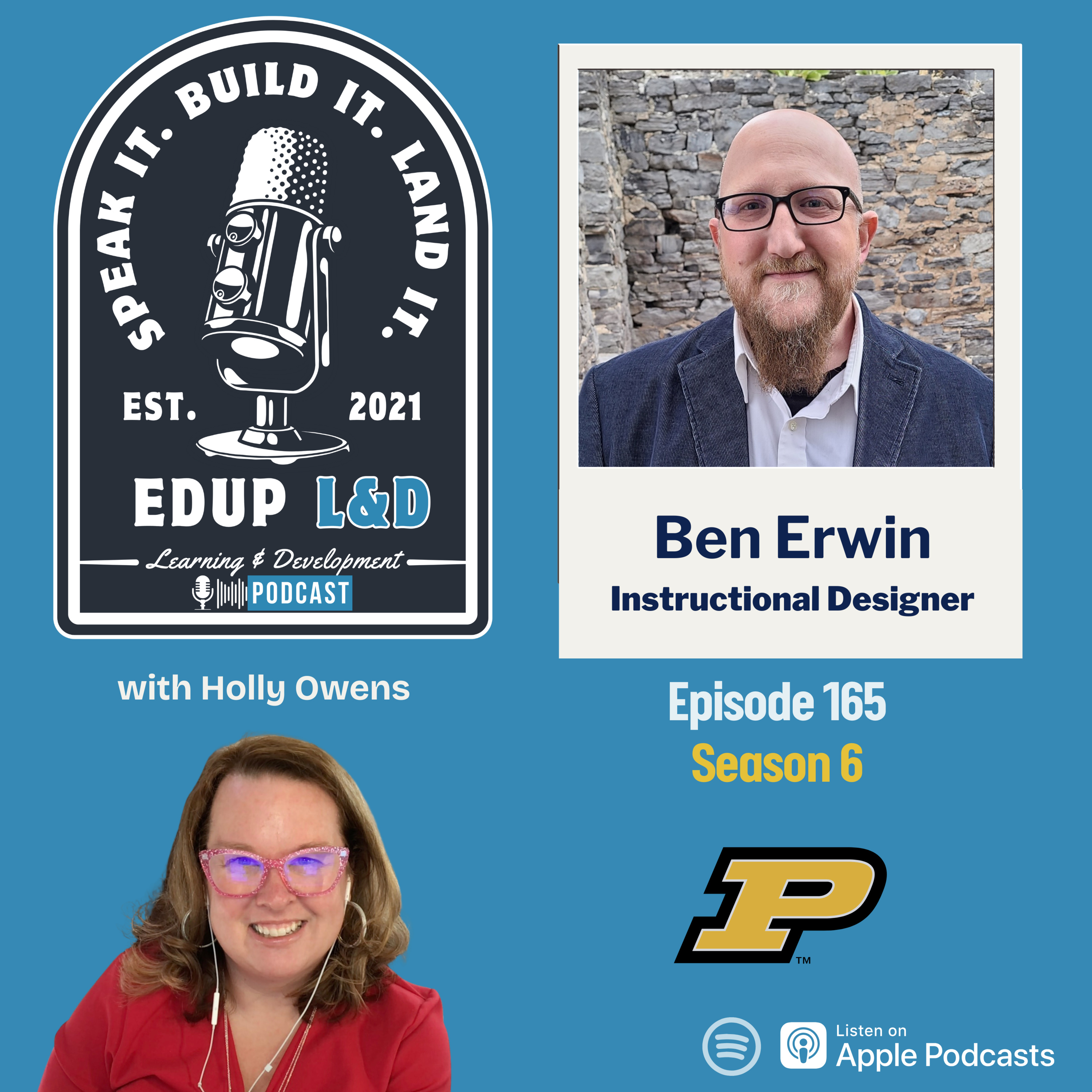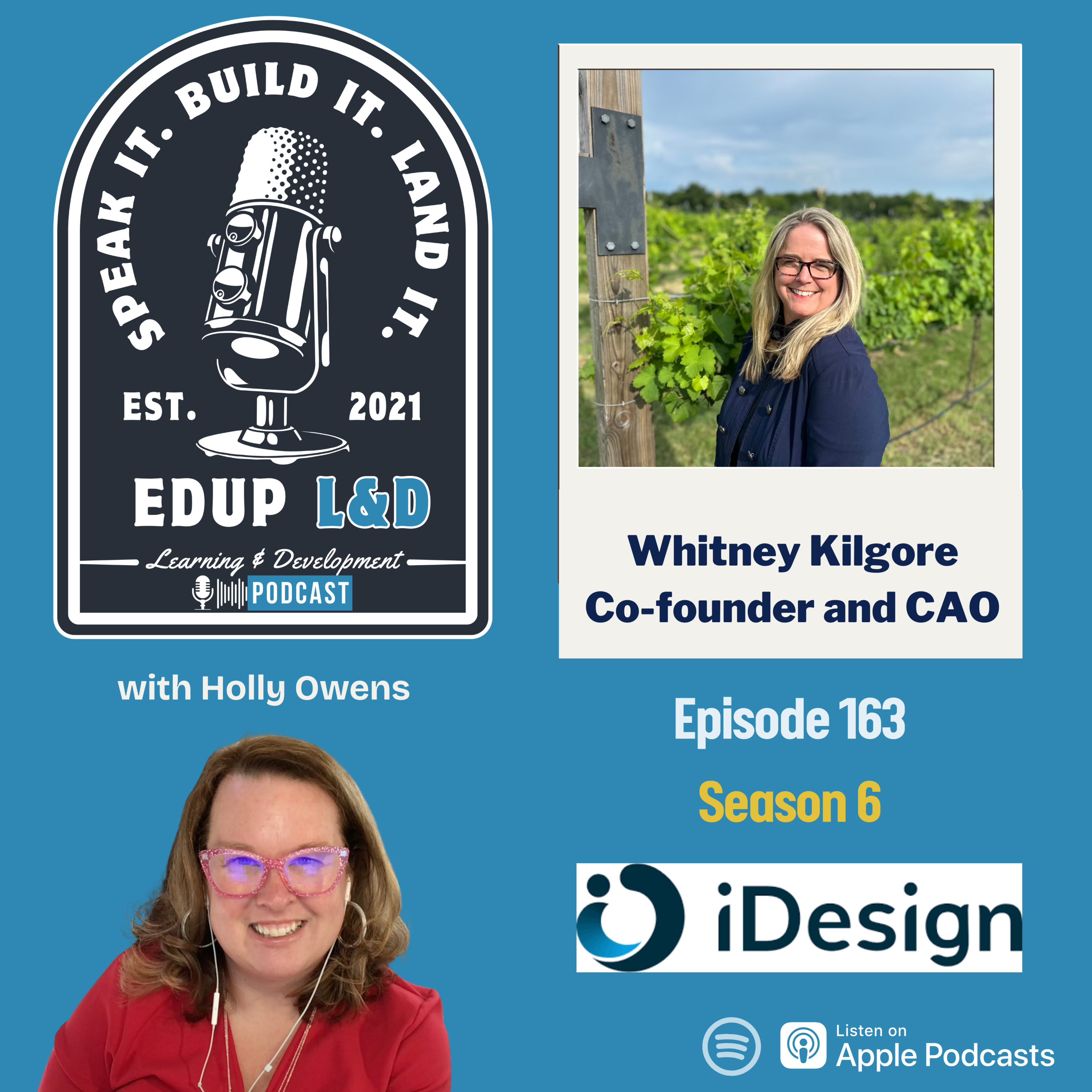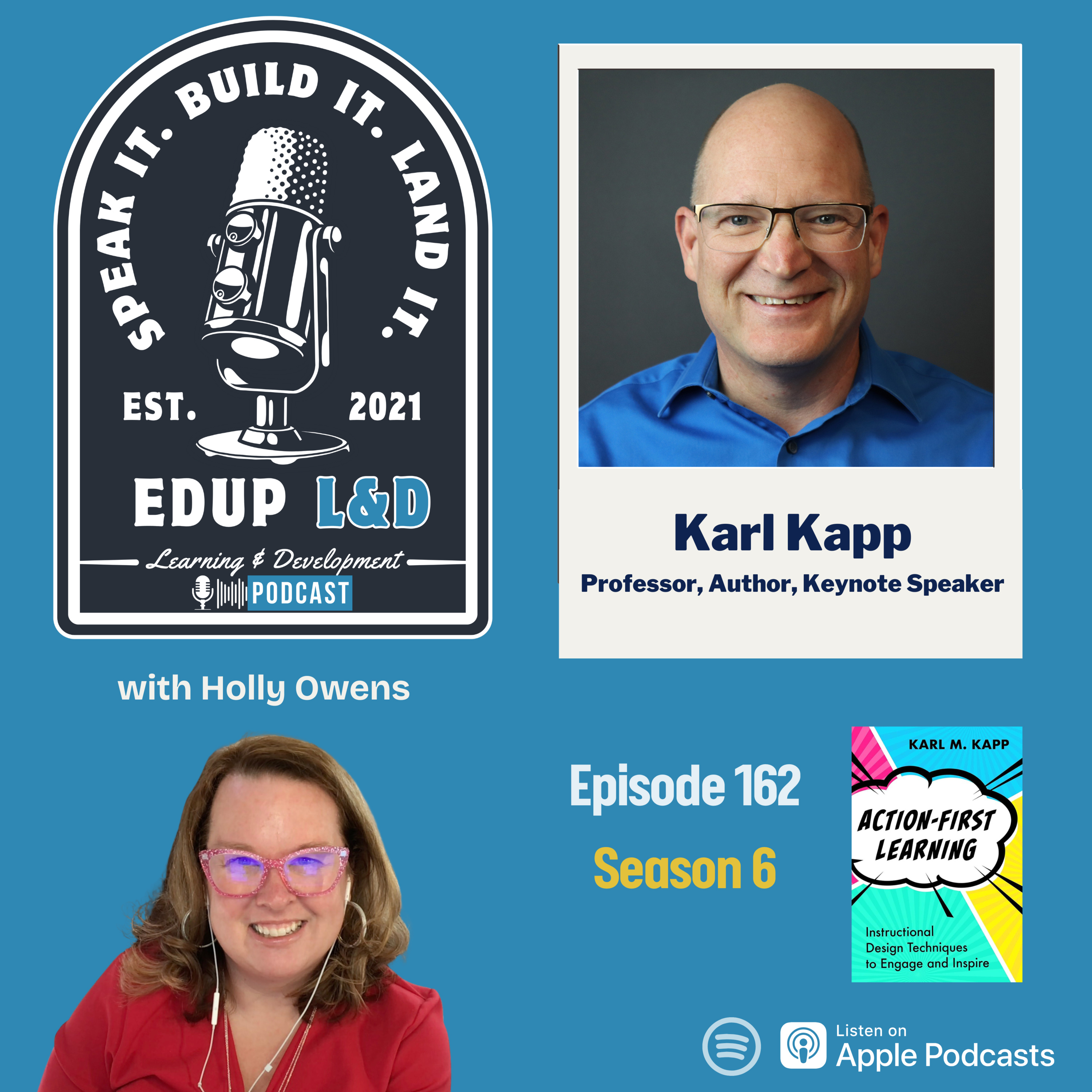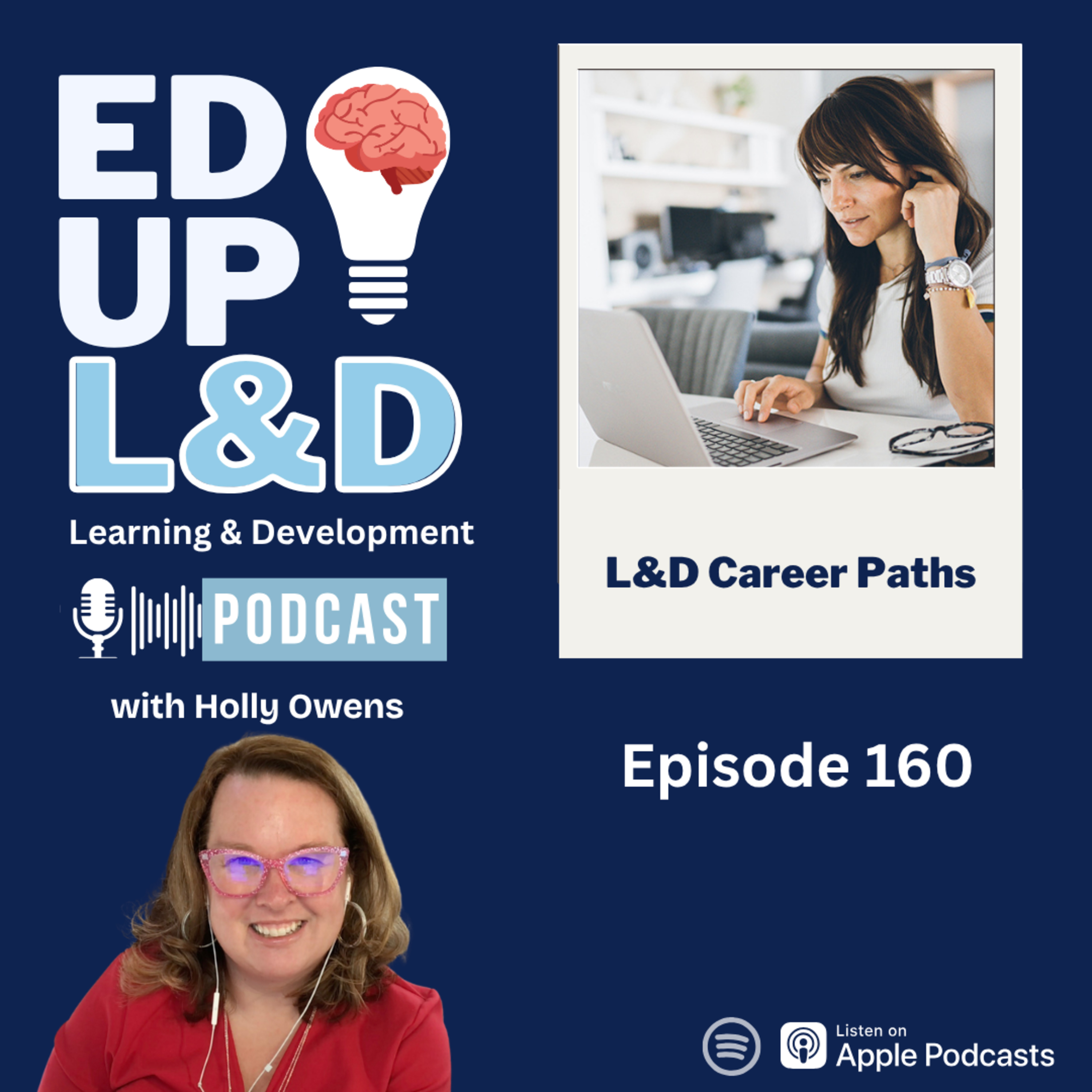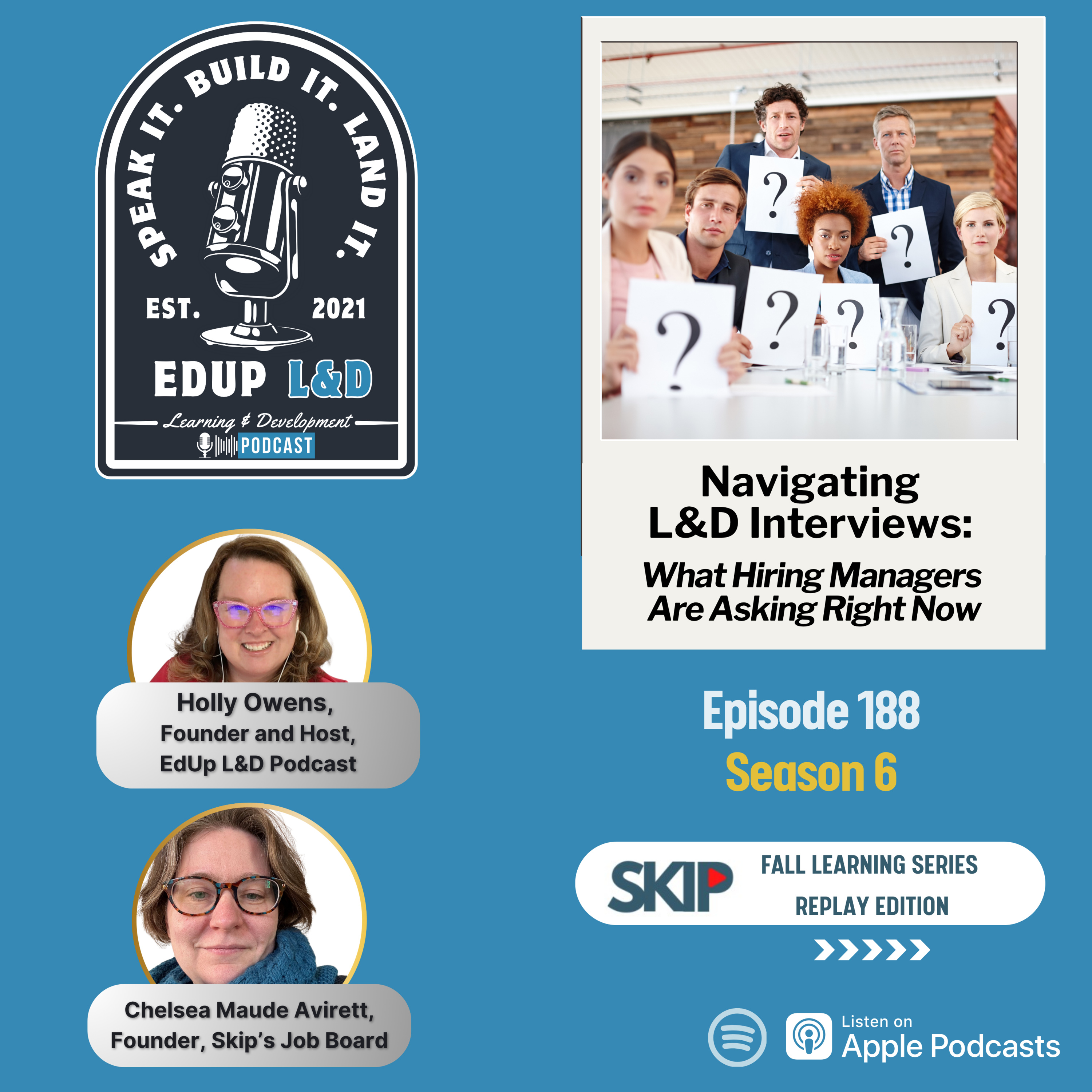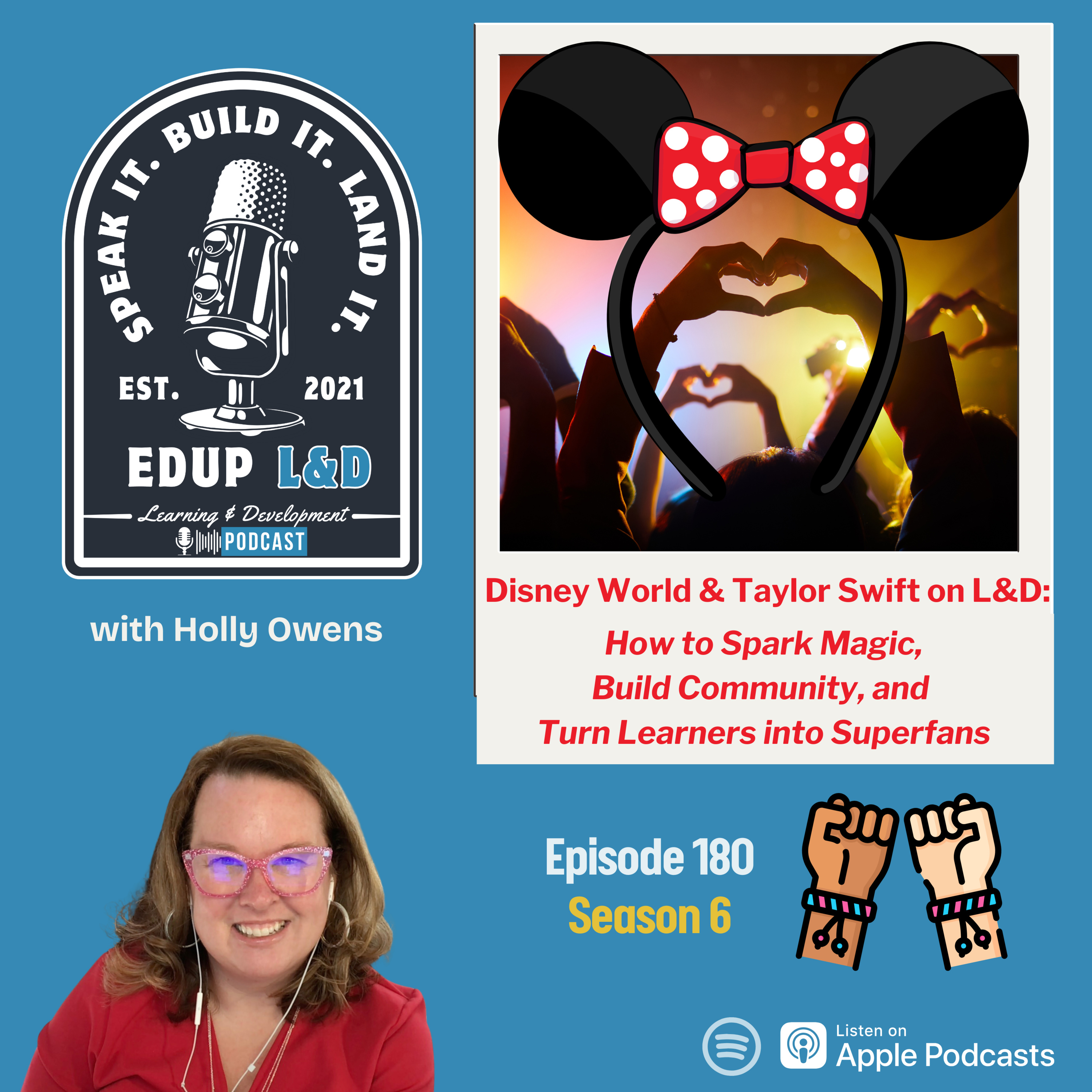
In this episode, Holly Owens explores the intersection of Learning and Development (L&D) with the engaging experiences offered by Disney and Taylor Swift. She emphasizes the importance of creating loyal learners by designing immersive and emotionally connected learning experiences. By drawing parallels between the fandoms of Disney and Taylor Swift, Holly discusses how storytelling, community building, and authenticity can enhance learner engagement and retention. The episode encourages instructional designers to think creatively about their courses, making them more than just checklist items, and to foster a sense of belonging among learners.
In this episode, Holly Owens explores the intersection of Learning and Development (L&D) with the engaging experiences offered by Disney and Taylor Swift. She emphasizes the importance of creating loyal learners by designing immersive and emotionally connected learning experiences. By drawing parallels between the fandoms of Disney and Taylor Swift, Holly discusses how storytelling, community building, and authenticity can enhance learner engagement and retention. The episode encourages instructional designers to think creatively about their courses, making them more than just checklist items, and to foster a sense of belonging among learners.
Get some Swiftie-inspired L&D podcast merch:
Connect with Holly:
___________________________________
Episode Sponsor: iSpring Solutions
🎙️ Huge thanks to our friends at iSpring Solutions for sponsoring this episode of the EdUp L&D podcast! 🙌
If you haven’t already, be sure to check out the iSpring Learning Exchange Community — a vibrant space for creators, educators, and L&D pros to connect and grow.
Grateful for the support and excited to see what our community creates 💡
Thanks for tuning in! 🎧
Holly Owens (00:00.846)
Hello everyone and welcome back to another magical episode of EdUp L &D. My name is Holly Owens and I'm your host and today we're gonna do something a little bit unconventional. We're gonna take a walk down Main Street USA, hop on the PeopleMover and then head on over to the Iris Tour. Yep, you heard that right. We are going to look at learning and development through the lens of Disney World and Taylor Swift.
two of my favorite things. So this episode might be more for me than anybody else, but every time I'm in Disney World or when I'm thinking about all the things that Taylor Swift is doing, I think about how all this relates to learning and development. You know, when I'm sitting on a ride about the experience and you know, how that intrigues people to continue to come back and back each time for that ride or continue to purchase
and follow Taylor Swift and all of her countdowns and all those different things. So one of the reasons I want to do this is because L and D, we definitely want our learners to be quote unquote loyal fans. And if we can get, we can learn from the best fandom builders in the world, Disney World, know, anything Disney, Taylor Swift, we can create something even better than learners. We can create loyal learners. So
Let me paint a picture for you. I recently just got back from Disney World. I went originally when I was five years old with my grandparents in 1988. And then I started going to Disney World more regularly again in adulthood. So at Disney World, there's a lot of different experiences. There's four different parks. know Disneyland exists that has a lot of different things as well, but my main experiences are with Disney World. So when you think about it,
At Disney, people wait hours, and I mean hours, and they are putting themselves in queues, and they're putting themselves, you know, getting pass-holder previews into new rides, just to be on a ride that is potentially, that's new, and maybe lasts four minutes or less, or a ride they've already been on like five times. They're still gonna stand in the line, no matter what, because for some reason,
Holly Owens (02:24.12)
Disney has psychologically gotten into our minds. And when we ride that ride, it's like, okay, you know what? I want to continue to have this experience. I want to continue to go back and ride, you know, Tron, or I want to ride Cosmic Rewind, Guardians of the Galaxy, by the way. That's my favorite ride. And then I also think about another one of my favorite things, Taylor Swift. I went to the Eras tour about a year and a half ago.
people will pay thousands of dollars. They'll trade friendship bracelets with strangers and scream and sing every song out loud. And the Eras tour was something like people were just putting, trying to find tickets. It was something that people really, really wanted. And Taylor Swift has built this loyal fan base of listeners, the Swifties, as you know. And...
I'm like, I'm in all of how she's built that community and Disney has done the same, pretty much the same thing. So I wanted to jump on here and do a solo episode about that because it's two things that I love. But as you know, I'm really passionate about L and D and thinking about like, how do we take these experiences that these mainstream things do, Taylor Swift, Disney World, insert whatever.
you know, television program here, experience here, like make them feel like they're gonna miss out. Fear of missing out on FOMO is a big thing. So when you think about it, the question I want you to ask yourself throughout this episode, how many learners in your organizations are they excited to take your e-learnings? Are they excited to take your trainings? Yeah, I thought so. So.
One of the things is that the magic that is created by these mainstream things that people feel like they have to have is it's not impossible to recreate. We really just have to shift our perspective and start designing experiences. And I always say this, it's an experience, an EdTech tool, it's an experience. It's not just the training, it's not just the pretty pictures on the screen, it's not just the simulations.
Holly Owens (04:41.237)
You want it to be an experience for the learner so that they feel connected to it. I feel very connected, although I am not like, you know, I don't know Taylor Swift personally. I feel very connected to her and she's done a great thing in developing, developing in communities and things like that. And then Disney, I feel super connected to the community of people who go to Disney more often or who ride certain rides or who like certain parks. I feel
a huge sense of connection to those communities. So let's go ahead and start off the episode talking a little bit about Disney World. So when you think about it, Disney World opened in 1971. They celebrated 50 years back in October of 2021. 50 years! That's 50 years of trying to change things, do different things. And that's a really long time. Disney doesn't just give you the ticket. They really...
If you think about it, if you know Disney pretty well when you go through the Disney World sign, it's called being in the Disney cone It's like you're in you're dropped into another world from the moment that you get through the into the Disney cone to you walk into the park You're in the Disney story whether that's Ani mal Kingdom Magic Kingdom Hollywood Studios or Epcot you're you're in the story we know
If you've ever been to Disney, you know the different parks and I can tell you that each of them tells a story. That each of them has different areas that you can go to. Like EPCOT is a range like it's the world. You're traveling around the world. You're going to different countries. You're experiencing the food in different countries. You're going on different rides that have different experiences. Like in Norway, there's frozen. Makes sense.
So just thinking about how you stepped in to that world and what it makes you feel like. And Disney does tap in a lot to the senses. So there'd be different smells on the ride. I know that's probably not possible for us to emulate that in something in e-learning design or in one of our trainings at this point, but really in L &D, means designing courses that feel like a journey.
Holly Owens (07:01.389)
They're not just a checklist item. The other day, my fiance, was sitting down. I could tell he was on e-learning, because I would hear a video, and then I would hear him click a couple times, and then I would hear another video or some audio, or then he was taking a quiz. And I was like, is that your e-learning training? What is that on? And I was inquisitive about all the different things that he was doing. It was a checklist item. It is really something that...
is not important to him. He said it was boring. He didn't want to do it. It took a 45 minutes to an hour of his time. And really what we need to do is shift that focus. Give learners a role. Give them a story. So again, when you're thinking about Disney World, they have this consistency of magic. And Disney World is the most magical place on Earth. And Disneyland is the happiest place on Earth. And that's the overall theme of things at the different parks.
Every cast member, every signpost, even the trash cans have personalities. People call them tables. They're all part of the experience. Like they have thought so deeply about things. They have hidden Mickeys. They've gamified. They've gamified the experience and people wrote books about finding the hidden Mickeys. They've wrote. They've done YouTube videos about like the underground, about Disney World and all the different things.
you know, talking about the tunnels under Magic Kingdom or, you know, like they just make it, it's mysterious and it's like, there's always something new to find out. So when we relate that back to us as instructional designers or learning and development professionals, we want to remember as we're designing that every touch point counts, every single touch point counts. It's part of the experience. So that means from the onboarding email,
to the way the LMS looks or whatever system you're using to log in, even the reminders, it should all feel intentional and it should always make the learners feel like they're a part of the experience and they're in control of the experience. Like we're providing the platform and the information, but they were in control of what they are doing. And I think back a little bit about this, I'm an 80s baby.
Holly Owens (09:19.109)
And when Mario came out, Super Mario Brothers, and playing that game, and then these things called cheat codes started coming out. It made you feel like you were doing something cool that was secretive, and then you see something happen on the screen that you could jump worlds or jump up different levels and do different things. Playing those games, it was like they started writing books about the cheat codes and what to do and the different buttons. It felt like...
beyond just like seeing, you know, standing outside Magic Kingdom from the inside, there's these different types of experiences you can see on the inside. So like I said, Disney Sprinkles surprises and you could say it's Disney Easter eggs like Taylor Swift. Little details you only notice if you're looking. So if you haven't heard of Hidd en Mickeys before and you're not a Disney person, if you ever get the chance to go to the park, there are tons of Hidd en Mickeys. And what I mean by that is that
There are making mouses put into areas you normally wouldn't think they would be put in. Like for example, there are some in pictures or some on different rides. And like I said, there's a whole book about that. So imagine if you're in learning in development and you hide these Easter eggs in your training. Hidden tips, gamified moments, unexpected recognitions, things that make the learner smile and think, that's clever.
And then they're paying attention. Something's happening in the brain, right? Like it's connecting to the content. It's really connecting them and they're like really thinking about it. And then they want more. They want to continue the progress. them want more, but not only are they learning, they are also experiencing something that is making them connect emotionally with content that they need to learn.
content and experience, a simulation or something that they need to learn. One of the things that Disney thrives on is people coming back again and again. I mean, when I went back to Disney after, it was a long time, in 2015, and I experienced it again for the first time as an adult, it was different.
Holly Owens (11:40.462)
And I wanted to keep coming back for more because I feel like even though I've been to Disney a lot, I still haven't experienced any everything. There's still more things to unlock. Obviously, there's the big things that people want to do. Magic Kingdom is the park that people want to go in that has all the princesses and like the big castle and Main Street USA, which I mentioned at the beginning of the episode. But if we think about this in terms of L and D, this means designing for continuous learning. And that's really what we want to do.
We're not just gonna launch a course and we're just gonna leave it and let people, that's it. We wanna create a pathway that makes people want to return. Because you know, learning doesn't stop beyond, even when you've completed the course, there's gonna be another course you're gonna have to take another time. There's gonna be another training that you have to take. There's going to be something where,
you have to learn something new at a certain point. And you're gonna wanna return to those previous lessons. Sometimes I call this going back to the basics. And you're gonna build upon, and we say this in K through 12, this is scaffolding. So when we're looking at Disney and thinking about how we can make L &D experiences more meaningful and make it a true experience and not just a checklist, you definitely need to have immersion, consistency,
of what's happening throughout the e-learning. If there's a character, if there's a persona that you're putting throughout that makes people pay attention. Some of the best e-learnings that I've taken, they tell a story. And through the story, either that's through a persona or they immerse their story with your story. And this activates prior knowledge and makes you connect to things, very constructivist.
When you're thinking about the Easter eggs too, and putting in surprises for learners, I know we had like a, when I worked at Amazon, we had like a surprise sound. was fun. It like, you know, emulated something that was out on the floor for the pharmacist. So embedding those Easter eggs again, or like the hidden Mickeys, and then you want them coming back for more. You really do. You really want loyal learners and you want people to enjoy
Holly Owens (14:03.467)
the experience, I don't think any of us as an instructional designer sit down and say, I'm gonna spend 200 hours on designing this five minute e-learning experience and I'm just gonna get the very basic done and just let it go. Like as an instructional designer or e-learning developer, you wanna be somebody, you wanna, I can say that I want this and I hope some of you listeners are.
paying attention and think this as well. I want people to feel like they walked away with something. I want people to feel like they were helped in some way. They have some sort of takeaway. They had that experience. They're able to do something better after they took the e-learning. It's not just something that's a checklist item. And people that are using it as a checklist item, we're beyond that in 2025. I mean, what...
what you're doing when you use something as a checklist item is you're just getting it done and you're wasting money and you're wasting other people's time. You're wasting the developer's time, you're wasting the designer's time, you're wasting the learner's time, you're spending unnecessary money if you're not aligning all these different things and truly making it an experience for the learner. So Disney World is a great example and I can tell you that one of the...
the rides I remember the most or two rides I remember the most through these experiences and some of these smells and sounds. One is Soarin'. You go through different, you fly through different countries and different places and they have smells and they have sounds. You remember that because you're smelling it and you're seeing it and you're hearing it at the same time. And then another big one too is Pirates of the Caribbean. That water smells awful, but you remember it. You remember...
it because it's part of the experience, you know, it's part of mainstream culture, pop culture, know, Jack Sparrow and the Pirates of Caribbean, but they bring the full thing together. And that's what we need to do as e-learning developers or learning and development professionals, instructional designers. Disney really is about the experience. And, you know, even though I've been numerous times now, I still want to go back.
Holly Owens (16:20.935)
I still want to go back. want to, know, Disney is always changing things and I want to, I want to experience those things and see how fun they are and what, they can come with next. The Imagineers. So when you're next time you're thinking about designing an e-learning experience, I want you to keep Disney in the back of your mind. All right. Now let's shift over to Taylor Swift. Let's, let's talk about, let's talk about Tay Tay as they put it, you know, she's coming out with a new album.
She just got engaged to Travis Kelce. She's everywhere. She's really quiet for a certain amount of time and you kind of get the inkling that she's working on something that she's gonna announce and the fans are like, they're predicting or they're making, they're saying that this might happen or it's gonna be reputation TV and TV for those of you who are on Swifties means Taylor's version. Recently she got back.
access to all her original so she owns all of her music, her discography I'm just thinking about like how obsessed people are with, in a good way, Taylor Swift and the Easter eggs that she plants throughout her different types of announcements or prior to the announcements. And she did say recently on the New Heights podcast that she doesn't plant Easter eggs about her personal life. It all has to do with her music.
So we're all thinking about maybe that, you why does that clock always point the midnight or why is the 13th floor a certain color jewel or why in the, the anti-hero video, she's dressed in like orange stuff because her new album is orange or, you know, we're always trying to figure out the puzzle because she does such a great job of
planting these Easter eggs to make us intrigued that we keep coming back for more. Maybe we keep seeing things that don't necessarily exist. So Taylor Swift has a vast amount of people following her. Good and bad, people saying good things and bad things. I've been a Swiftie for a while now. And I definitely, you know, when I went to the Eras tour, it was unbelievable. So if you're a Swiftie, welcome to the...
Holly Owens (18:41.921)
Welcome to the podcast where I'm exposing myself being one I'm a huge Swifty and I'm 41 years old. I love Taylor Swift. I think she is one of the most authentic people out there. but she does a great job of, know, thinking about her fans, thinking about who's, who's following her and her influence spans across generations. There's younger people, there's older people. and really everyone feels welcome in that community.
So one of the things that she does really, really well and that we should be doing in L &D is storytelling and providing authenticity. Every era that Taylor talks about or music that she puts out is different. Folklore doesn't sound like Reputation, but it's still Taylor. It's a piece of her. know, through storytelling, she's having us experience these different...
episodes, maybe these different things that people are going through, maybe herself, she's going through, if somebody close to her that's going through something that they're going through, but she's telling it through music and telling it through a story. L &D can do this. We can do this. We can shift styles when we need to, but always staying true to the why. Learners, and this is,
done through research that when they feel connected, it's because the experience is authentic. It's not because, when I'm talking to you this podcast, I'm just talking. I'm just saying what I think. And it's truly authentic about what I think. I'm sharing my experiences and I encourage all of you to think about your experiences and some of the things that you love that do this. know, Taylor Swift and Disney World might not be.
your go-to's like they are mine. So really when you're making something that's authentic and not feeling it again like a checklist item, learners sense that. So it has to be something that's truly authentic. And I'm not saying every learning experience is gonna be like this top notch, like Taylor Swift album, Disneyland ride, but you can build up to this. You can make it so that the experiences maybe it's a little bit, know, bleak at first and then it,
Holly Owens (21:08.595)
it builds into these other things, but really, learners sense the authenticity. So you need to do that storytelling and authenticity, number one. The second part is the community creation. And I'm going to say Taylor Swift is probably the best at doing this because I have never seen another person, celebrity or otherwise that has created a community that they're not just the fans, they're part of a movement.
There's the friendship bracelets, there's the Easter eggs, the hashtag. She's created her own culture, her own Swifty culture. And can you imagine what learners would feel like if they were a part of a community through your course? Like discussion boards that don't feel like homework or checklist items, they're actually conversations, authentic conversations. You're truly connected with people.
Some of the best experiences that I've ever had in learning are because I'm connecting with other people. Projects that target this, building those connections, shared rituals are things that make training memorable. Like what is that? How do you make learners who are in all different places across the world feel like they're part of something with each other when they're not seeing each other?
And how do you do that? How does Taylor Swift, when she announces an album, how does she within, you know, like so many hours breaks the record for the most podcast downloads of the New Heights podcasts so quickly? How does that happen? It's not just something that's happening in a vacuum. It's something that's been building up to something that's been planned out.
So thinking about how you make those communities where people, even when Taylor is going on a sports podcast, and I'm a huge sports person, and she's learned the sport of football, how does that podcast get that much attention? And it's not directly related to Taylor Swift, it's related to her fiance, but how do they get that much attention?
Holly Owens (23:32.556)
Like how do they get that many downloads? How do people feel so connected? You know, through a different ways. Just imagine like being a part, like those two communities coming together and meshing, know, little girls thinking about going to football games. Like that's not something that I would say that people normally say, like, I'm going to take my daughter unless she's like this, this huge athlete. Also thinking about too, like, just, you know,
No, there's really no dumb question about like sports at this point. You know, and see bringing Taylor into a Kansas City Chiefs game has I think I heard this on the not the radio. I heard this on the news is like like 1.6 billion revenue for the Kansas City Chiefs. And Taylor Swift is literally sitting in a suite at the game. And she's not doing anything but being herself.
She's being out in the community, she's built a community. like, I can't say enough. Like building a community that's authentic is going to continue to make people want to be loyal and be a part of the learning experience and really taking what they need to know and then connecting that, you know, inside the materials. I know I'm asking a lot. I'm asking a lot. I'm definitely asking a lot through this episode.
Holly Owens (25:05.997)
I'm really, I know I'm asking a lot. I'm really asking a lot with this. When I'm talking about all these different experiences of things that Taylor's doing, of things that, you know, Disney World is doing, but I want you to be able to really think outside the box of what you are doing now.
whether that's measurable learning objectives, whether that's aligning assessments and doing the same assessments, quizzes, things over and over again, the way you've always done it, it's gotta be done different now. There's things like AI, adult learners don't wanna be bored, they wanna take, they want immediate takeaways that they can put into practice as soon as they leave your e-learning, whether that's something that's for their jobs. So I've really thought about these different things.
And another thing too that Taylor does is beyond the storytelling and the authenticity and the community creation, the personalization and connection. I don't know Taylor Swift and some of you who are Swifties listeners right now. I mean, if you know Taylor Swift, congratulations, but she writes songs and does things that make them feel like they're just for you.
Like you're just sitting in a room with her by yourself and you're hearing her play a certain song. You know, like it's something that's strictly personalized just for you. Like listening to some of our songs at different periods in my life, I connected with them more than I did at other certain periods of my life. And the albums definitely emulate different experiences. So you can do this in L &D too.
So you really wanna make, when you're thinking about L &D, you wanna make the learning relevant to the roles, the goals, and the real, real life problems. Learners need to feel like they are seen. Like we truly need to empathize and understand what our learners are going through. We're all learners too. We're not just the instructional designers. We've been in training experiences. So we really need to understand what they are going through.
Holly Owens (27:21.813)
what they are experiencing in their roles, what they are maybe experiencing outside of their roles, because there's a whole bunch of different areas. There's health stuff, there's exercise stuff, there's a whole bunch of different ones I can list. then there's a personalization and connection. The fan loyalty for Taylor Swift equals trust. They stick with her because through all of her reinventions and
Before Taylor Swift, was Madonna. So for you as an audience, remember Madonna. Madonna, she re-invents herself quite a bit. And Taylor Swift definitely does this. Is something that through these re-inventions, she's still the same person at her core, but she's just going through a different phase in her life. And she always delivers. She always delivers. Can you imagine what that would be like if learners actually trusted us and there wasn't this animosity between, I have to take another E-Learning?
I have to sit there another hour training just because the boss says I have to do it. It's not something I really need to know. What if we could shift that mindset through our learning experiences? The training could be valuable, engaging and actually worth their time. Actually worth their time. I'll repeat that. What a difference that would make in our world.
I feel like trainings, learnings, education, know, name all the things that we learn through really get a bad reputation. No pun intended. You know, when it comes to what we have to do in the workspace or what we have to do to, to grow. If you think every time when you sit down to design something, whether that's an infographic or that's a step-by-step how guide, how to do something.
and you could earn the trust of your learners and make it valuable, engaging and worth their time. Imagine how good it would feel to have that sort of stuff. And people have done this, know, making sure that people feel connected. As you all know, I've worked at, I worked at Yellowdig recently as a director of growth marketing and I'm a huge advocate of Yellowdig because of the way
Holly Owens (29:50.72)
it is set up to connect people and the authenticity around that. and I, as an instructor find that totally valuable and seeing the way that my students have connected through there and got to know each other, it changed. It changed their perspective on the course. It changed. Like they felt less intimidated by the things or like they didn't feel like some of the things they were doing were checklist. They were asking questions. They were inquisitive about
certain areas of learning and development or instructional design, it just feels like they trusted each other and they trusted me. Like we built a community throughout the 14, 16 week semester.
All right, I could go on and on about this, so I'm going to wrap up the episode. So the things that Disney and Taylor Swift have both mastered is the experience. It's immersive and it's emotional. It's connected to the psyche. They have consistency. Every detail aligns like one thing is related to the other and the other thing is related to the other. And it's all connected in this vast world of different different things.
Community, people belong to something bigger than themselves. Swifties are huge community. Disney adults are huge community. As much bad rap as I get, feel like Disney adults are so much fun. Surprise and delight, gamification, those little moments that people experience joy, that keeps people hooked. It's not the negative stuff. It's not like the, if something negative happens in an experience, why would we wanna go back to that? We don't, we don't.
That's not good for our minds. So the surprise and delight. Now tell me that these things experience consistency community and the surprise and delight. That doesn't sound like the holy grail of learning and development
Holly Owens (31:48.056)
Like what you can do to change your learners' experiences. You know what that does for you too? It changes your whole experience as an instructional designer because you feel more connected to your learners. Like we talked a lot about trust. Here are three things you can do today to make your learners more like Swifties and know, through the Disney World experience. Audit your learning, number one, audit your learning like a Disney ride.
Where's the magic? Where's the long wait line? Fix that friction. What is happening in that experience that is just not working? What do you need to do to kind of shift that? Number two, ask yourselves, would learners buy the merch from your course? In other words, would they proudly share it on LinkedIn or tell their peers about it?
When people love something, they share it. They want to tell other people there's word of mouth. That's like the best marketing ever is when it spreads through word of mouth. are they gonna buy into your course? Are they gonna share it on different sites? Are they gonna share it with their friends? And then number three, add one Taylor Swift move in your experience. Maybe it's storytelling. That's something I really love to do. Maybe it's an Easter egg.
Maybe it's just making your content more human. We are humans, in fact, did you know that? So at the end of the day, learners don't wanna feel like they're passive attendees. They want to feel like fans, and fans come back for more. So your challenge for you, something that I'm giving for you to do, the next time you design something,
The next time you're thinking about designing a curriculum or program, it's find your hidden Mickey or your Taylor Easter egg, something small. These things are small. They're not huge. Then make sure learners feel like they're a part of something bigger, something special. Because we're not just training employees. We're building loyal learners. And that's where the magic really happens. Thank you. See you next time.










